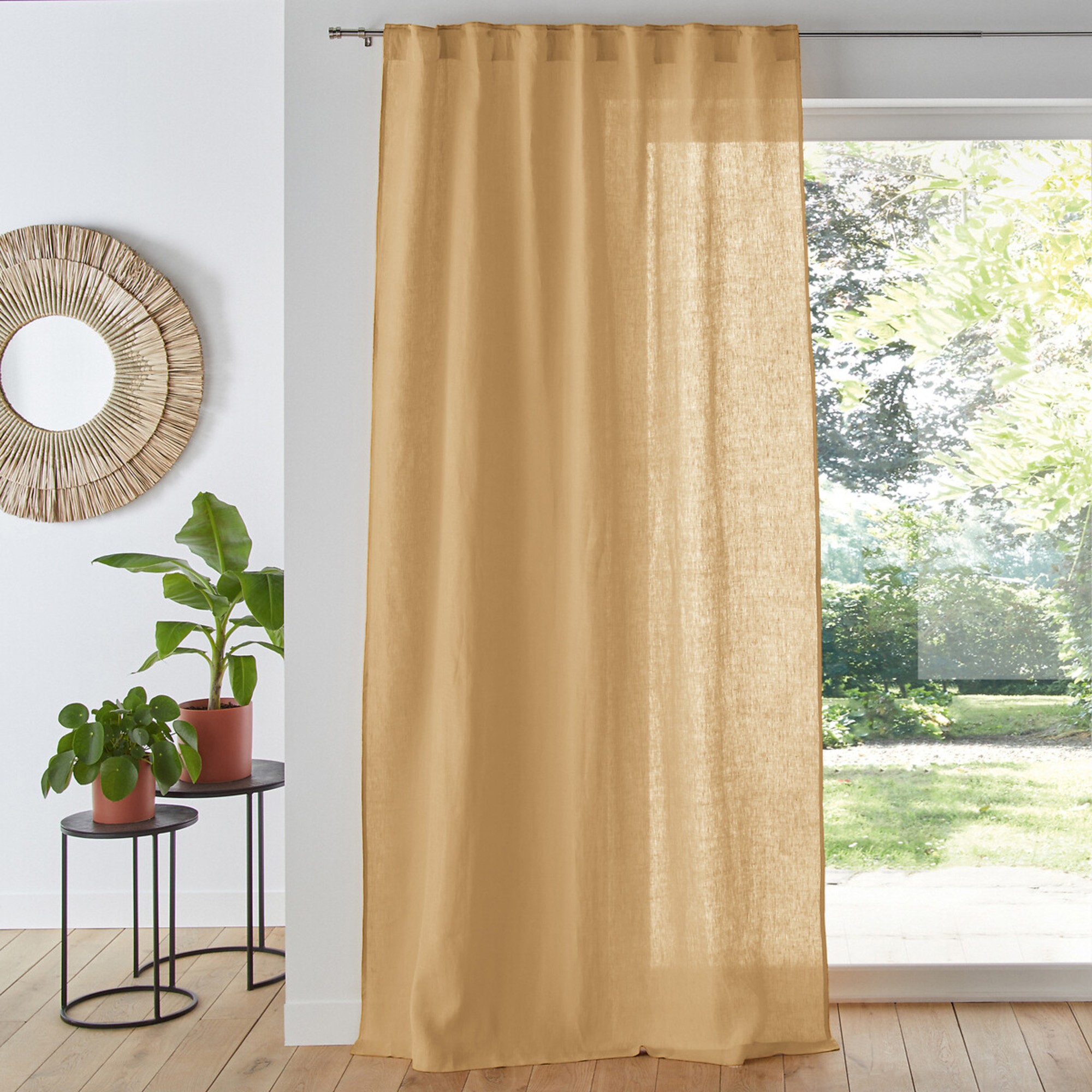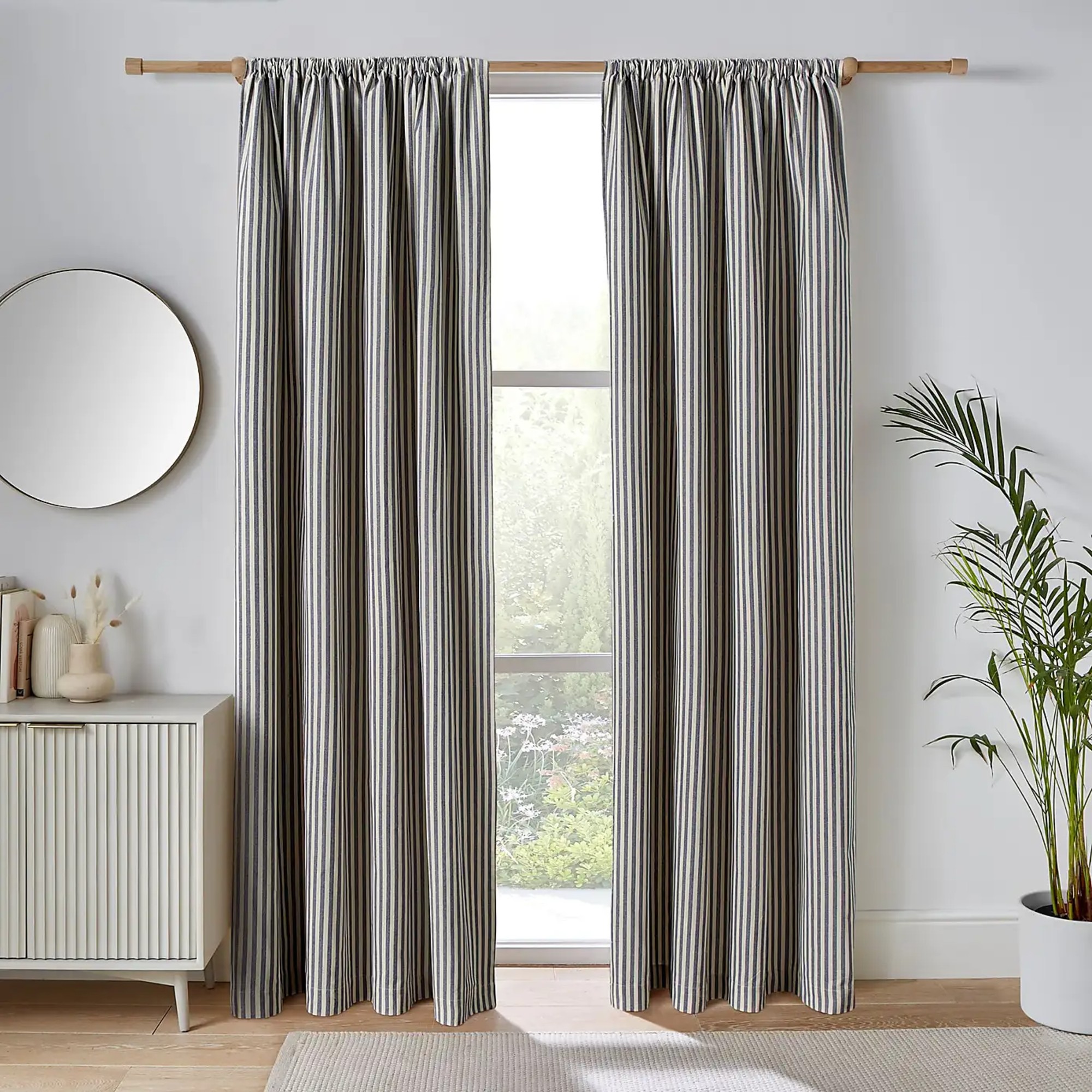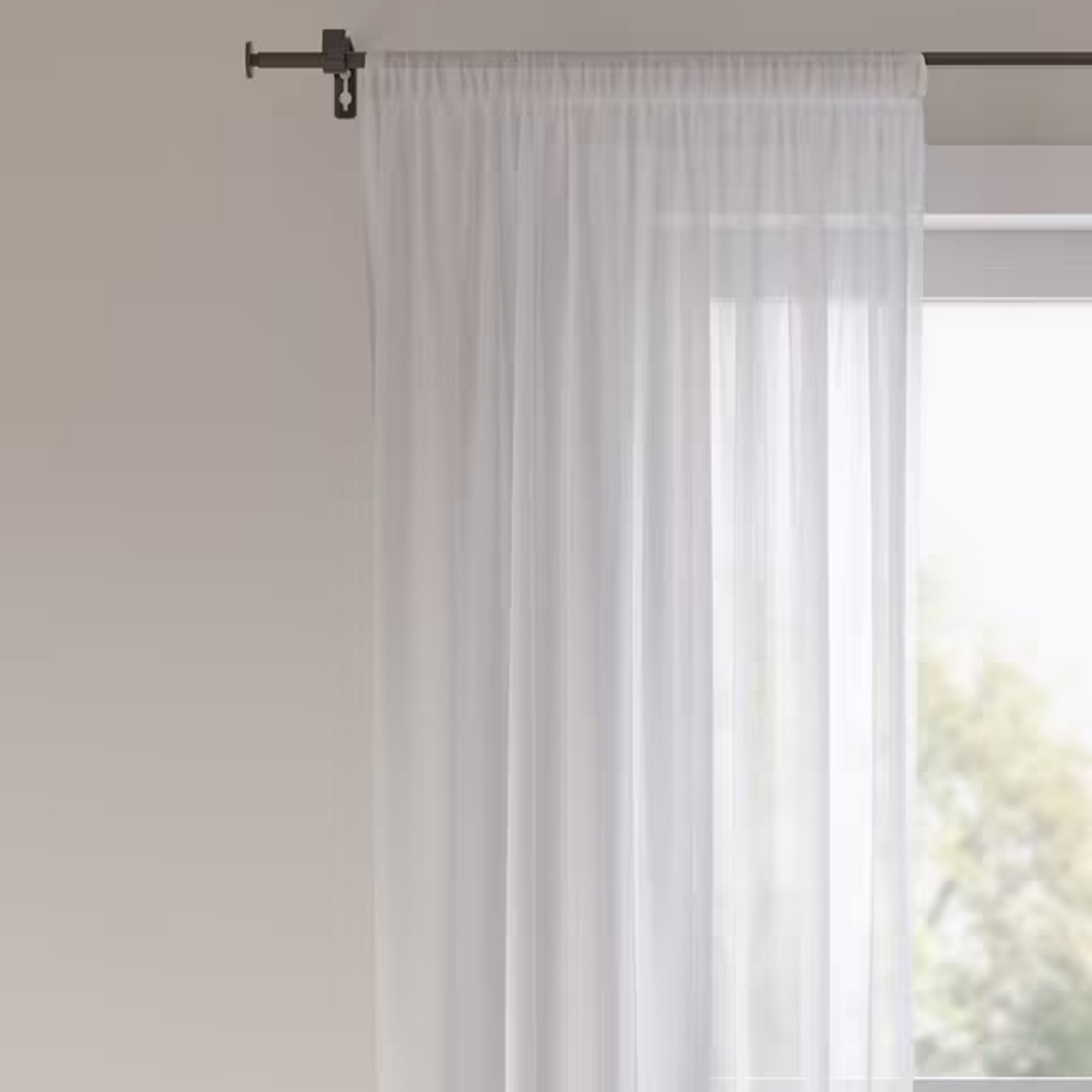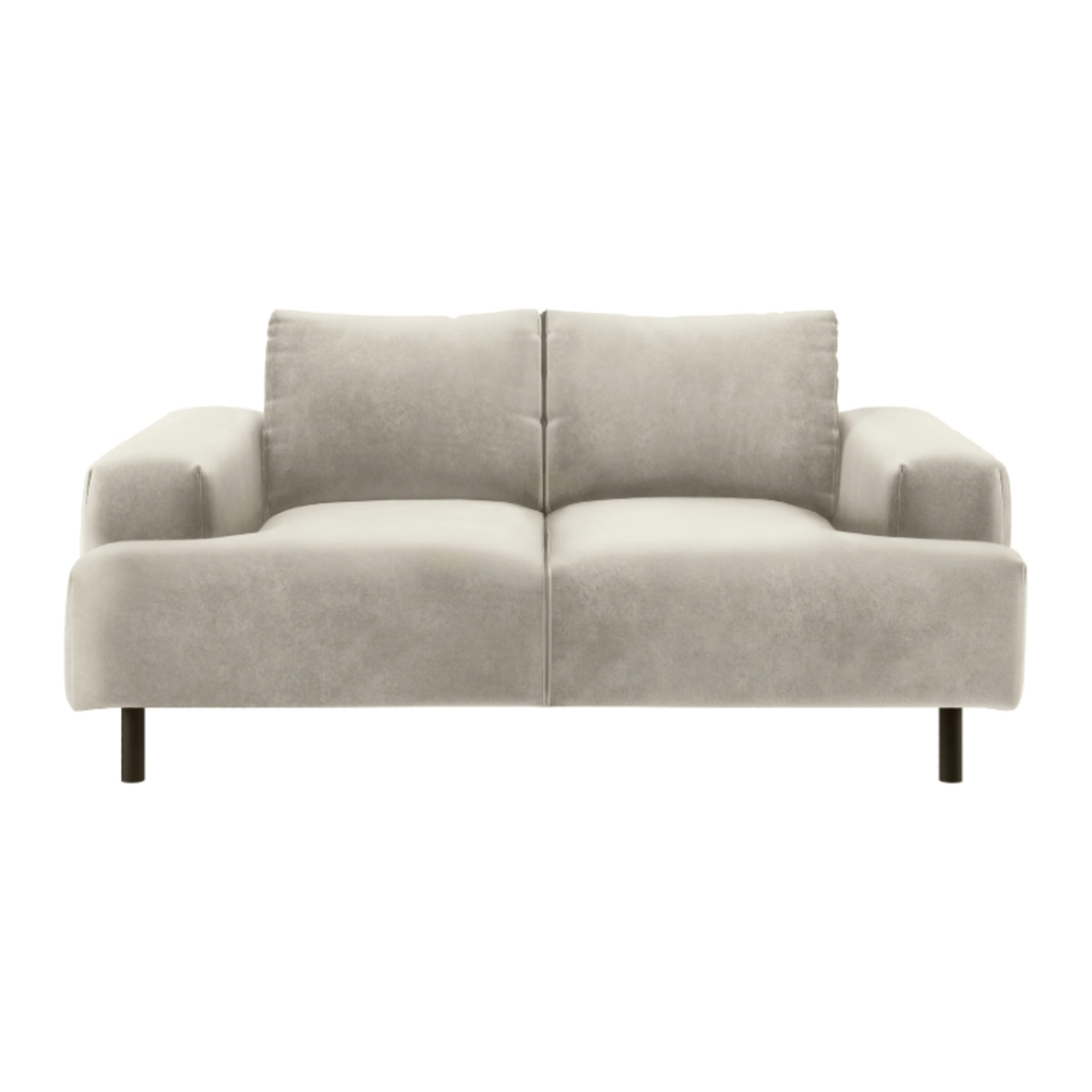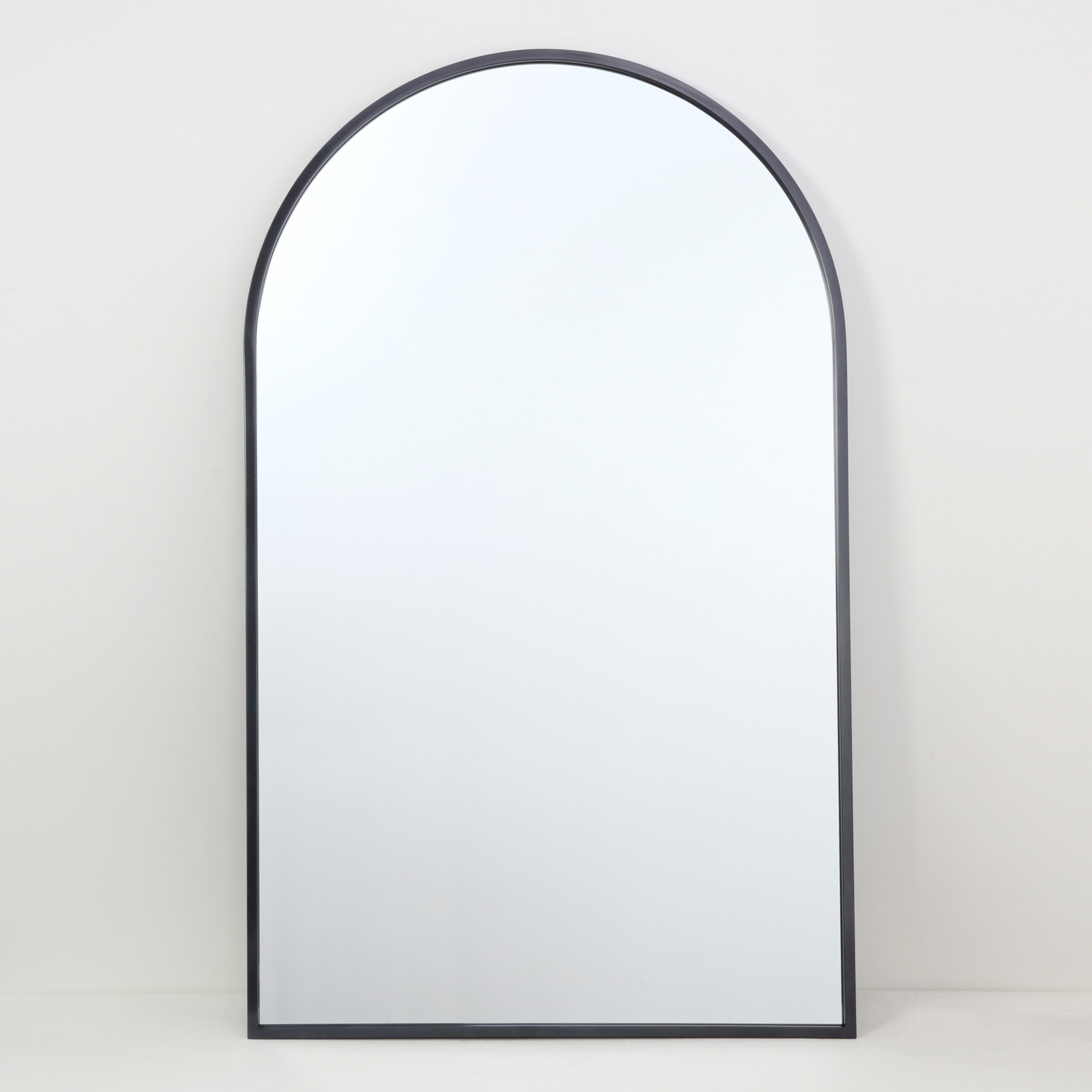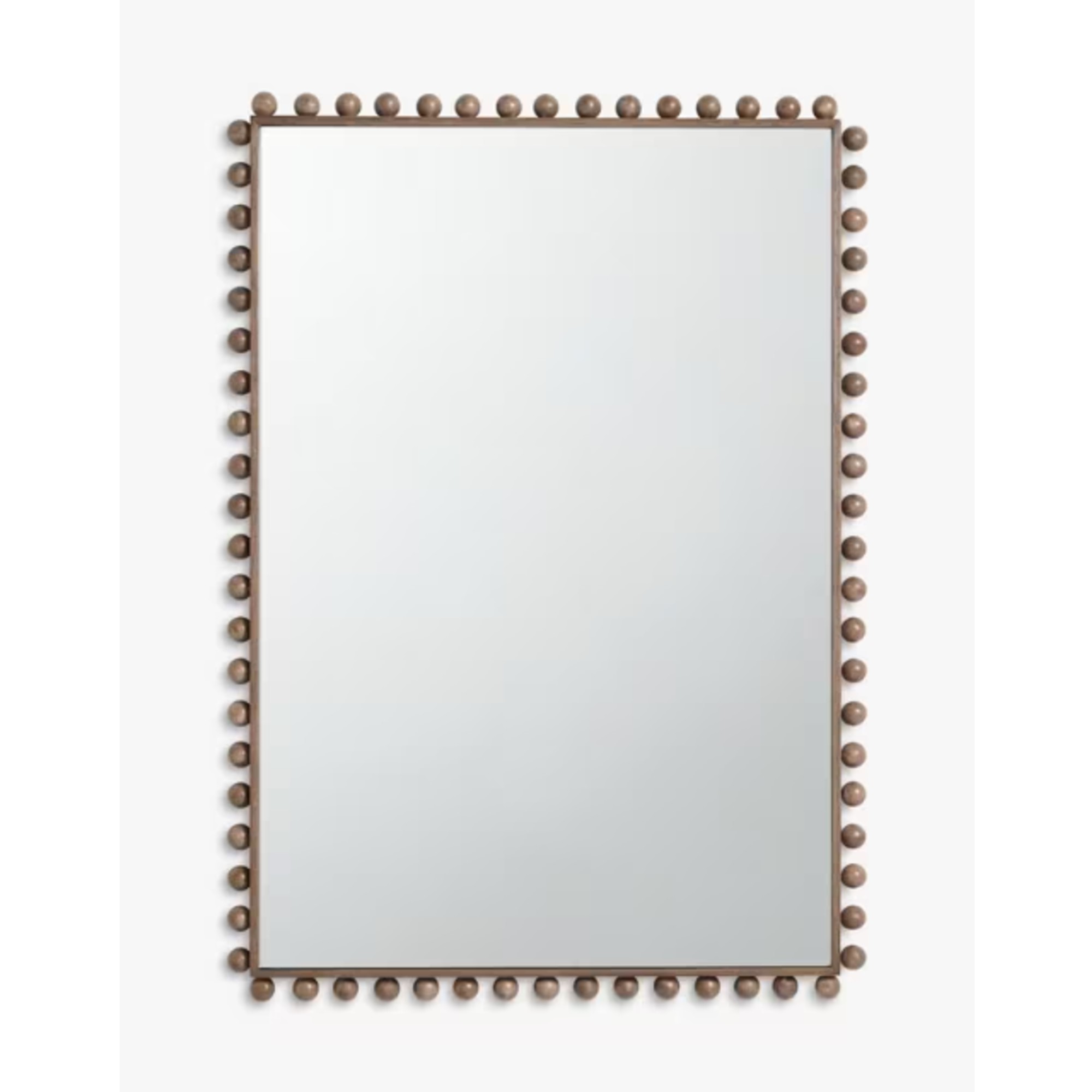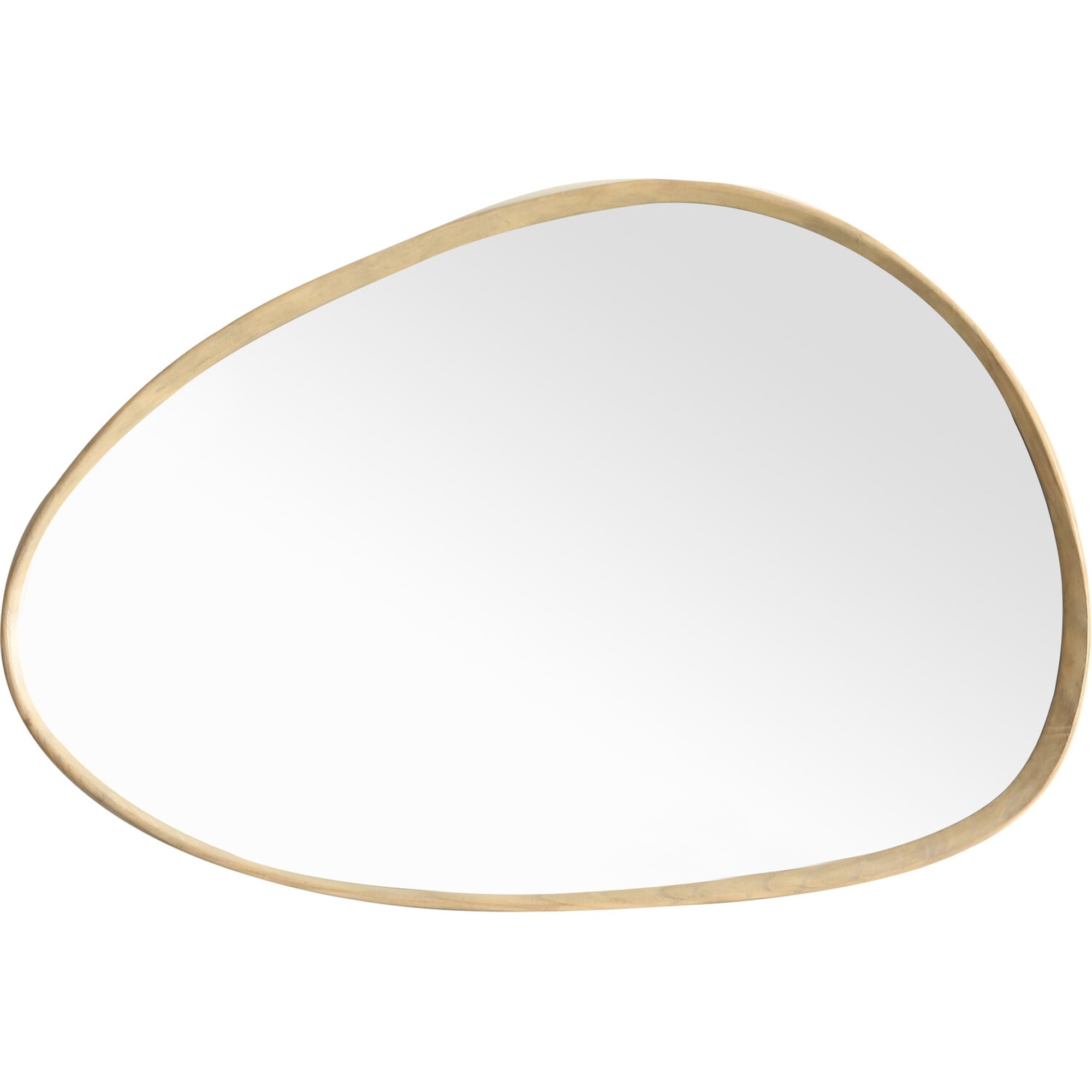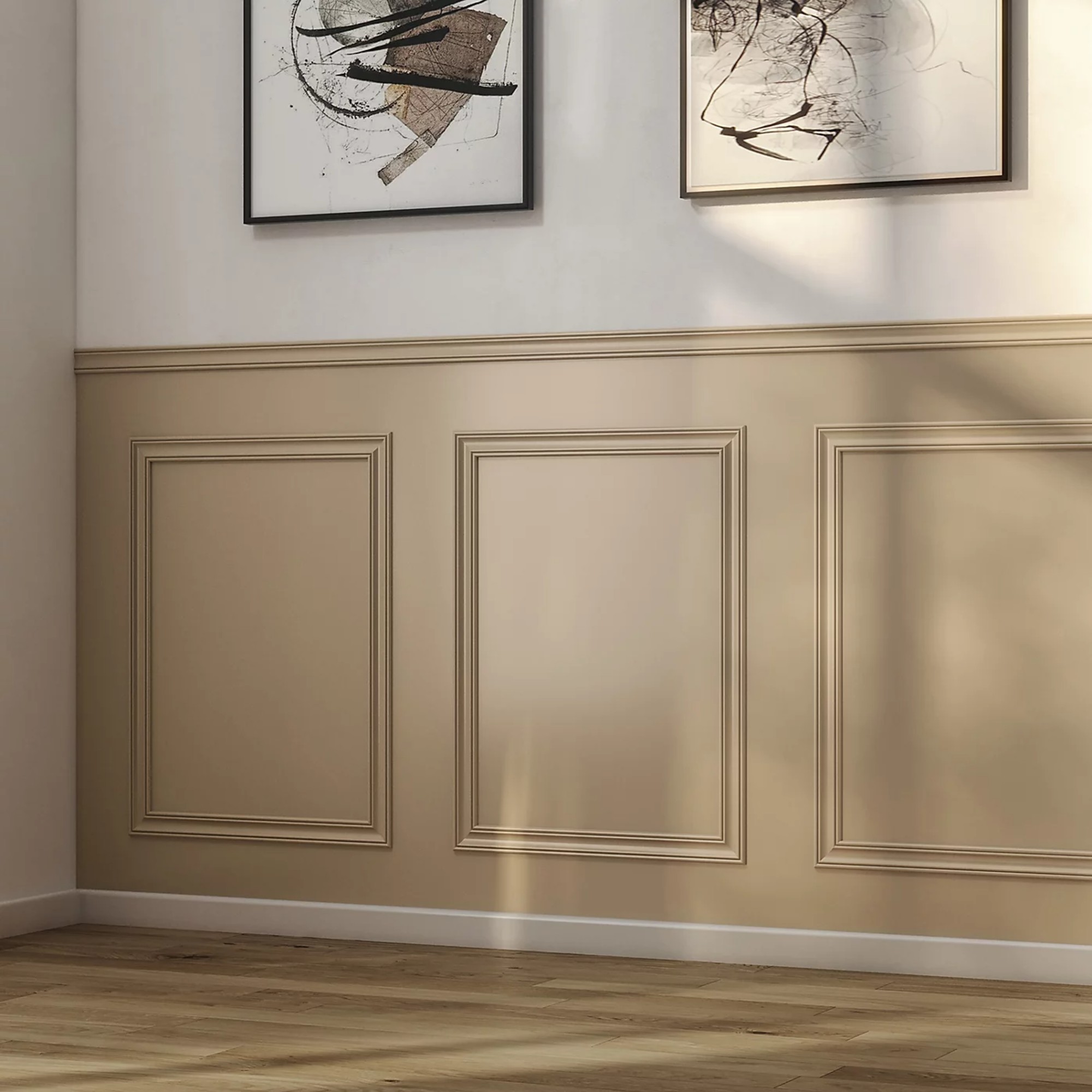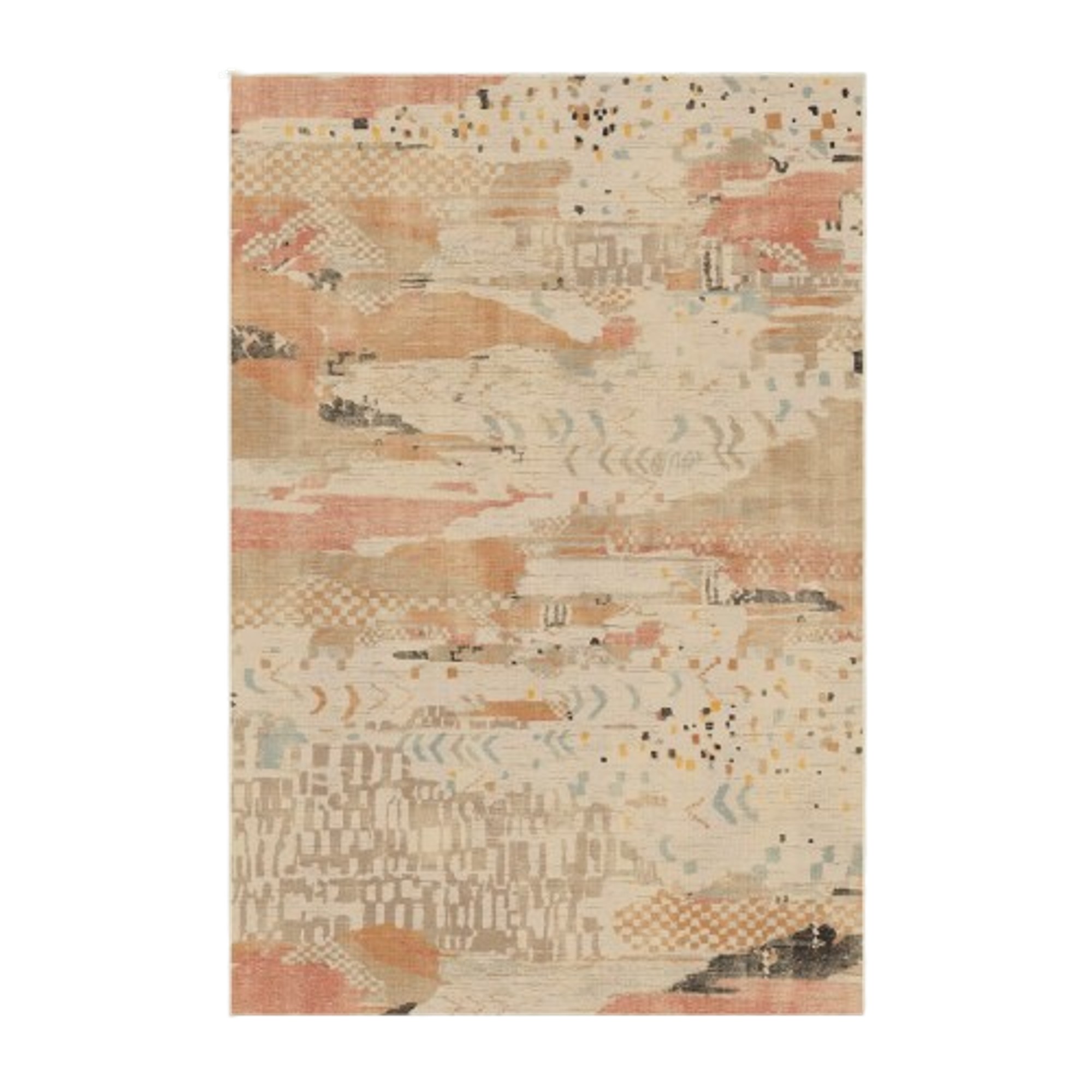How to make a small living room look and feel bigger – 19 ways to expand your space with clever colour, curtain, sofa and mirror tricks
Want to visually stretch your tiny lounge? These are interior experts' top tricks to do so

Lisa Fazzani
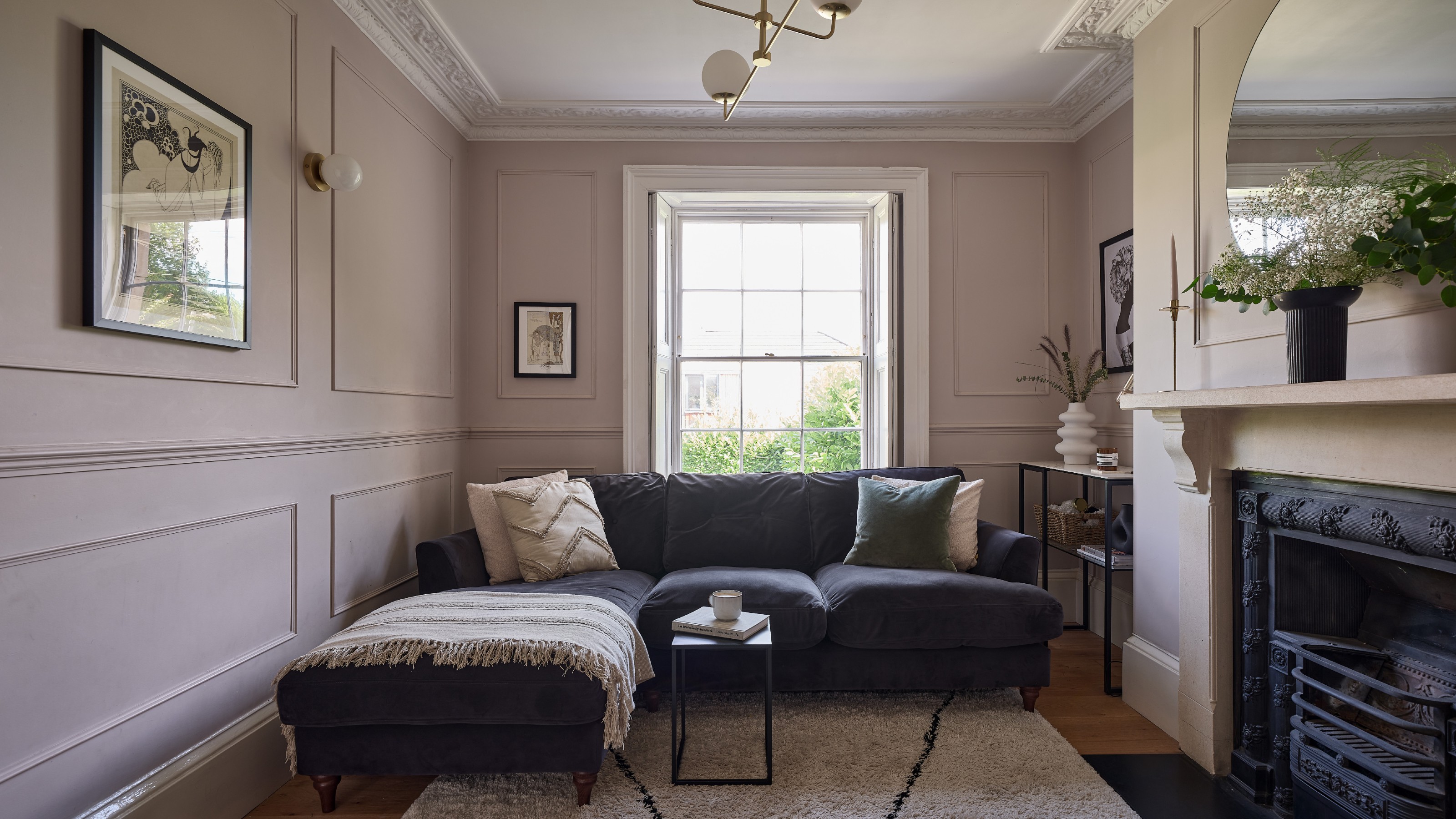
- How to make a small living room look bigger with colour
- How to make a small living room look bigger with curtains
- How to make a small living room look bigger with a sofa
- How to make a small living room look bigger with mirrors
- How to make a small living room look bigger with decorating
- How to make a small living room look bigger with furniture placement
- FAQs
Having a small lounge is not uncommon these days. And while there is charm in embracing its tiny nature and making it even cosier and more cocooning, more often than not, our instinct is to look for tips and tricks on how to make a small living room look bigger instead.
And there are many different ways and small living room ideas you can put into work to visually expand your living space – with the help of everything from the right living room colour scheme to clever small living room design rules.
‘By being clever with colour and using styling tricks you make your room feel larger than it is and still beautifully designed with your personality at the forefront,’ says Tash Bradley, director of interior design at Lick.
How to make a small living room look bigger with colour
1. Colour drench the space
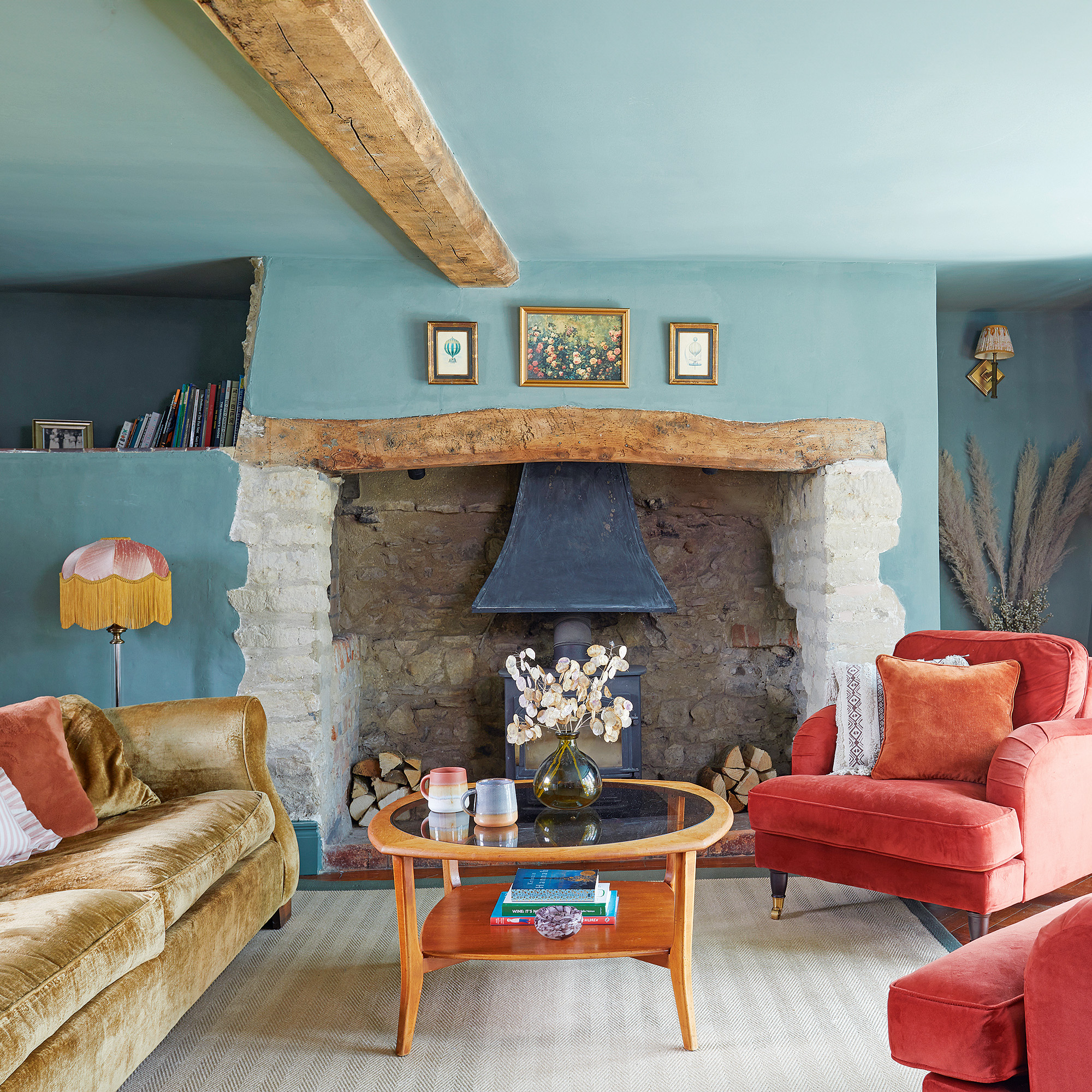
Colour drenching is one of the biggest home decorating and paint trends of the last couple of years, covering all surfaces of a room in the same colour. But it’s also the perfect clever tool to make a living space appear bigger than it is.
'It’s not always about the colour, but it’s as much about how you use it,' explains Michael Rolland, managing director at The Paint Shed. 'Contrasting between wall and ceiling is a big no for me when it comes to small rooms.'
Tash at Lick, who’s also a big colour drenching advocate, continues, ‘My biggest decorating tip is colour drenching. Contrasting woodwork and ceilings will draw attention to the size and shape of your living room, which in a small space, will only make it feel smaller. By colour drenching, a technique where you paint your walls, woodwork and ceiling in a single colour, you soften the contrast and blur the lines of each element and in turn open up the space.’
2. Opt for a light colour palette
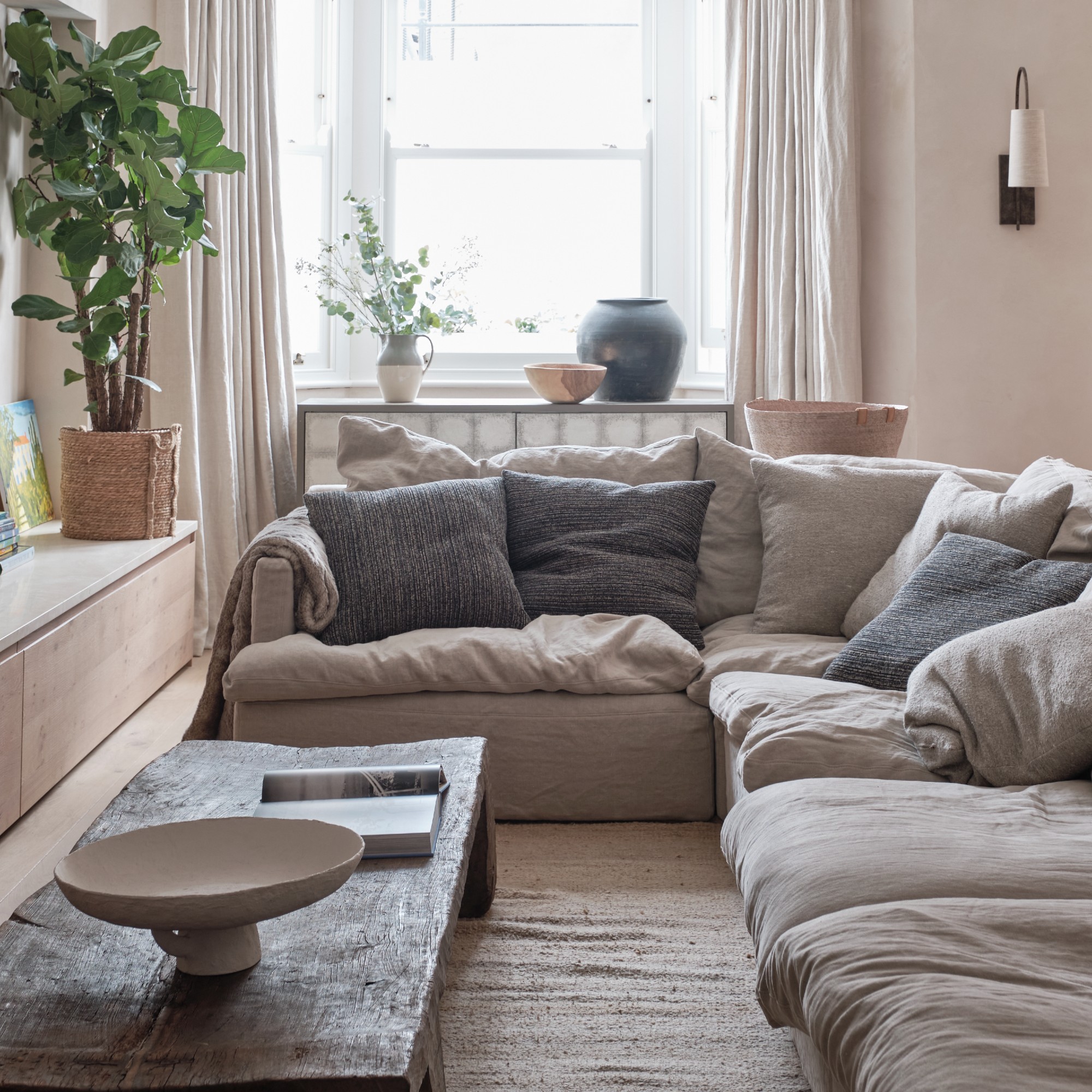
The fact that light colours make a room (and other things too) look bigger and dark shades do the opposite is nothing groundbreaking – but it is effective. So sticking to lighter, ideally neutral shades, especially on the walls, is ideal if you want to make your living room appear larger.
Sign up to our newsletter for style inspiration, real homes, project and garden advice and shopping know-how
‘Colour plays a key role in opening up a space and making it feel larger,’ says Shelley Cochrane, accessories buyer at Furniture Village. ‘You don’t have to stick to neutrals to make a room feel bigger though – gentle blues, greens or blush tones can all create the illusion of space as they are pale enough to reflect light. The key is to avoid very deep and dark tones, like plum, navy and teal for example, which whilst cosy, have the opposite effect and make a room feel smaller.’
Kelly Collins, interior designer and head of creative at Swyft, continues, 'The best colours to make a living room appear bigger are generally light shades of paint, such as soft warm whites, creams, taupe, or pale pastels. Light colours can reflect natural and artificial light, which helps to create an illusion of spaciousness and openness. Additionally, these colours tend to recede visually, making walls appear farther away and the room feel larger.'
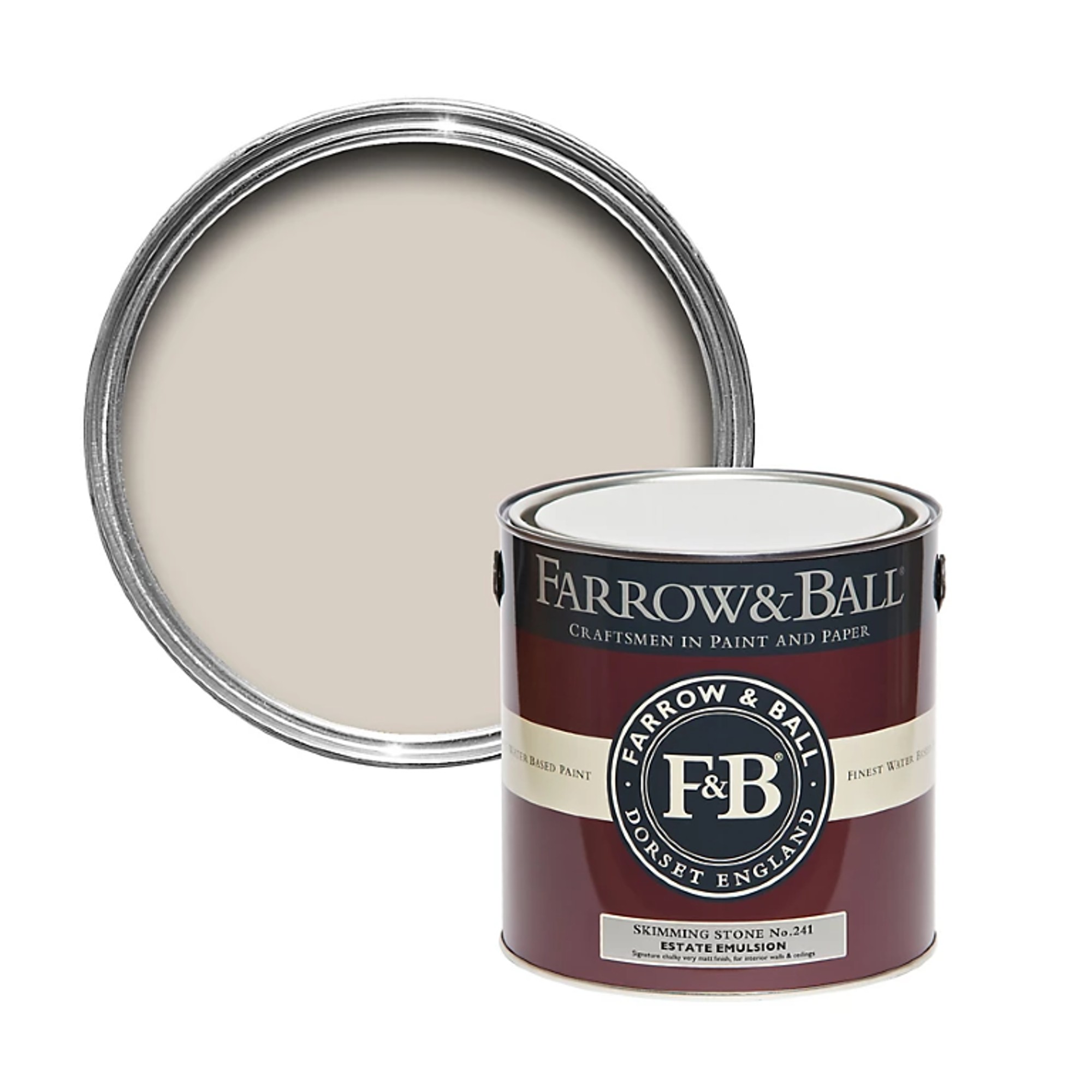
If you're after a neutral shade for your walls that isn't white, Farrow & Ball's Skimming Stone is one of interior designers' favourite neutral paints.

Soft blues like Lick's Blue 15 are a fresh, timeless and relaxing colour choice for any small living room. And it's no accident that blue living room ideas are trending.
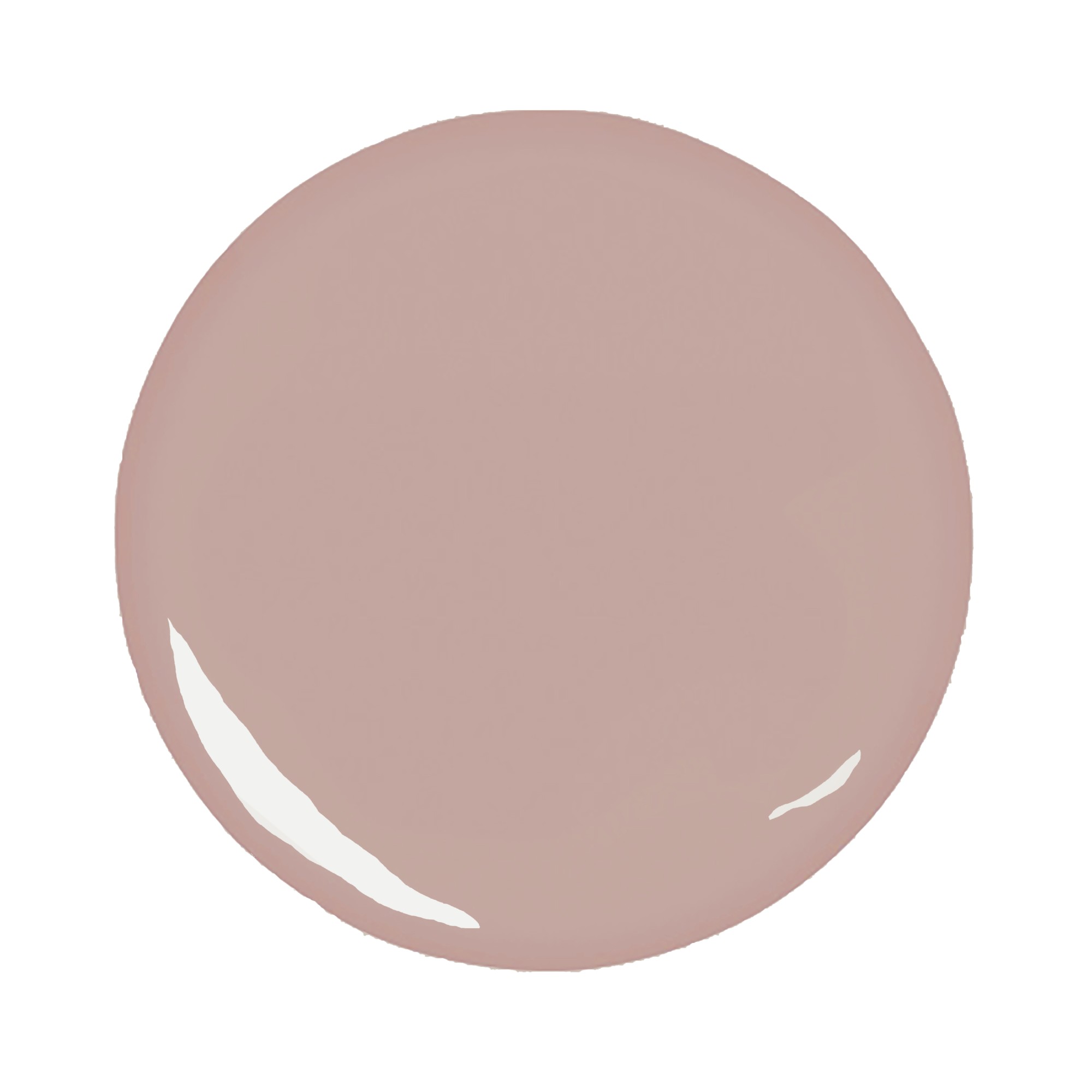
Soft and even earthy pinks are another firm favourite colour choice when it comes to living room colour schemes. This dusky pink shade from Earthborn is not only beautiful, it's eco-friendly, too.
How to make a small living room look bigger with curtains
3. Go for full-length curtains
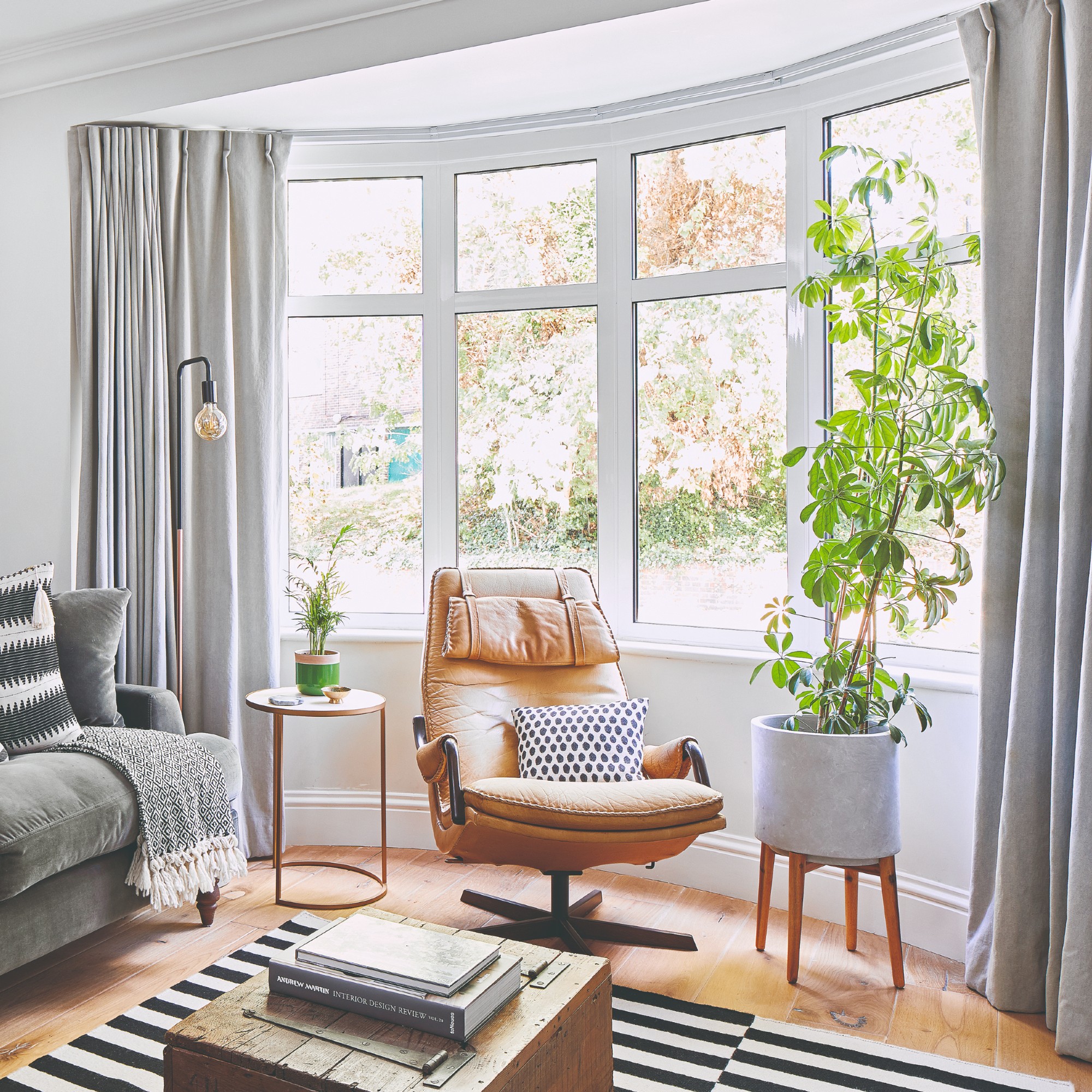
You can make your small living room look bigger and more expensive just with some curtains. As long as you know what living room curtain ideas to go for here.
‘Opting for longer curtains might seem counterintuitive, especially in smaller rooms, but floor-length curtains are perfect for adding height,’ says Anna Jones, interior expert at Furn. ‘They create the illusion of high ceilings, making a room appear taller and more spacious, while also adding an instant touch of luxury. Whereas short or middle length curtains can actually cut your room in half and make the space feel smaller.’
Ana Zuravliova, trend specialist at Blinds Direct, adds, ‘Floor-length curtains with a soft pooling effect at the bottom are both timelessly stylish and will make the room feel larger. If that finish isn’t to a particular taste, having your curtains sit just above the floor works just as well.’
4. Let more light in
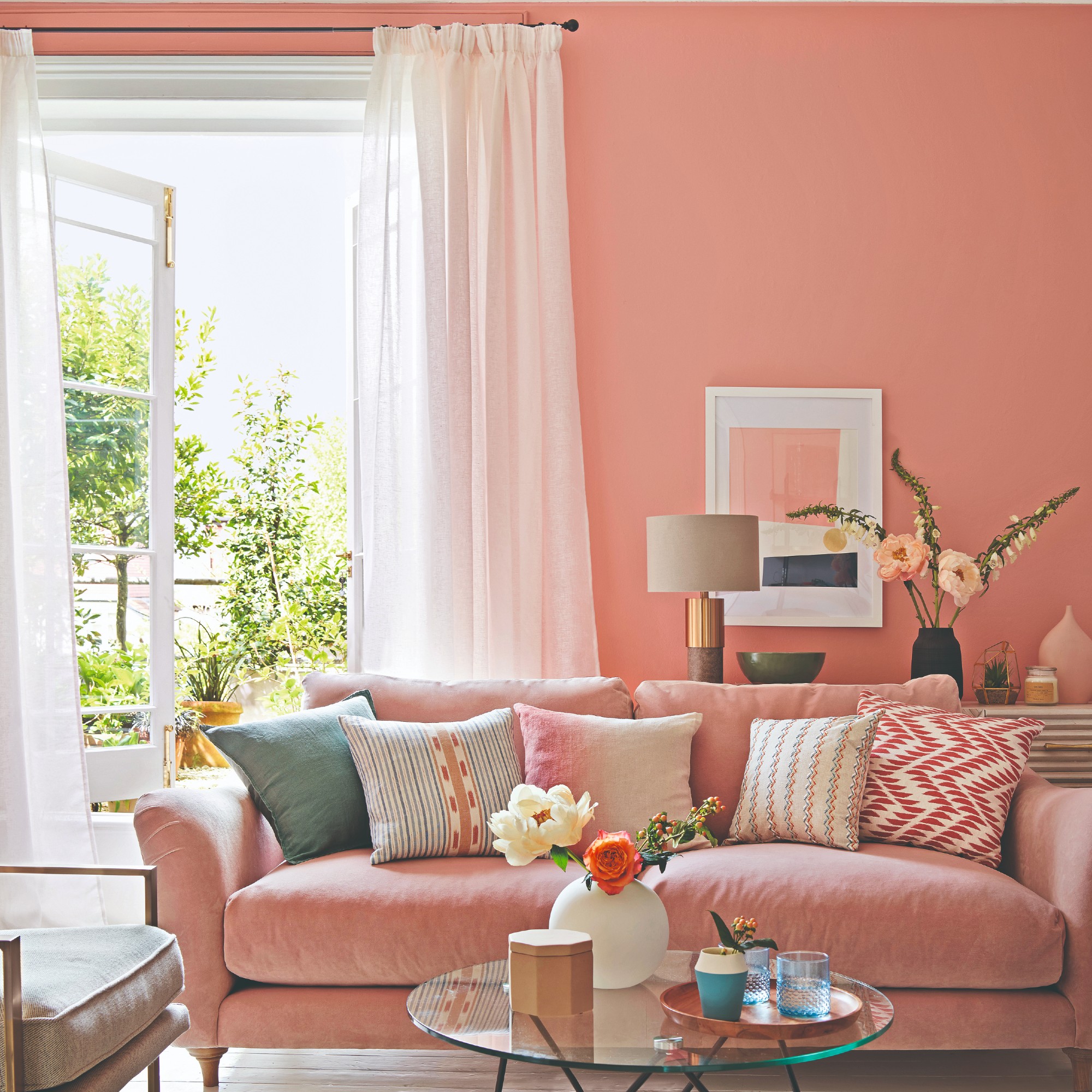
Natural light can help with how to make a small living room look bigger, making it feel brighter, breezier and more spacious. Avoid heavy living room curtain ideas and solid blinds that block out sunlight and instead opt for lightweight linens, voiles and sheers that will let maximum light flood in.
‘Voiles and lighter fabrics will let natural light into a room while maintaining privacy. By better illuminating a room, it will feel more spacious while still stylish. For best results, consider a recess-fit voile curtain with a thicker, blackout curtain covering the recess. This gives you the flexibility to enjoy both soft sunlight and total darkness when required,’ Ana at Blinds Direct says.
Rea Bell, design expert at Furn, adds, ‘When you're working with a smaller room, it's a good idea to steer clear of thicker, heavy materials like velvet. While these fabrics are undeniably luxurious and can add a wonderful touch to your space, they can easily overwhelm a small area and create a heavy atmosphere. If you love the look of textured fabrics, I highly recommend opting for curtains made from materials like linen. They can truly transform your living room, making it feel bright and airy while adding that touch of textural style you want.’
5. Opt for light curtain colours
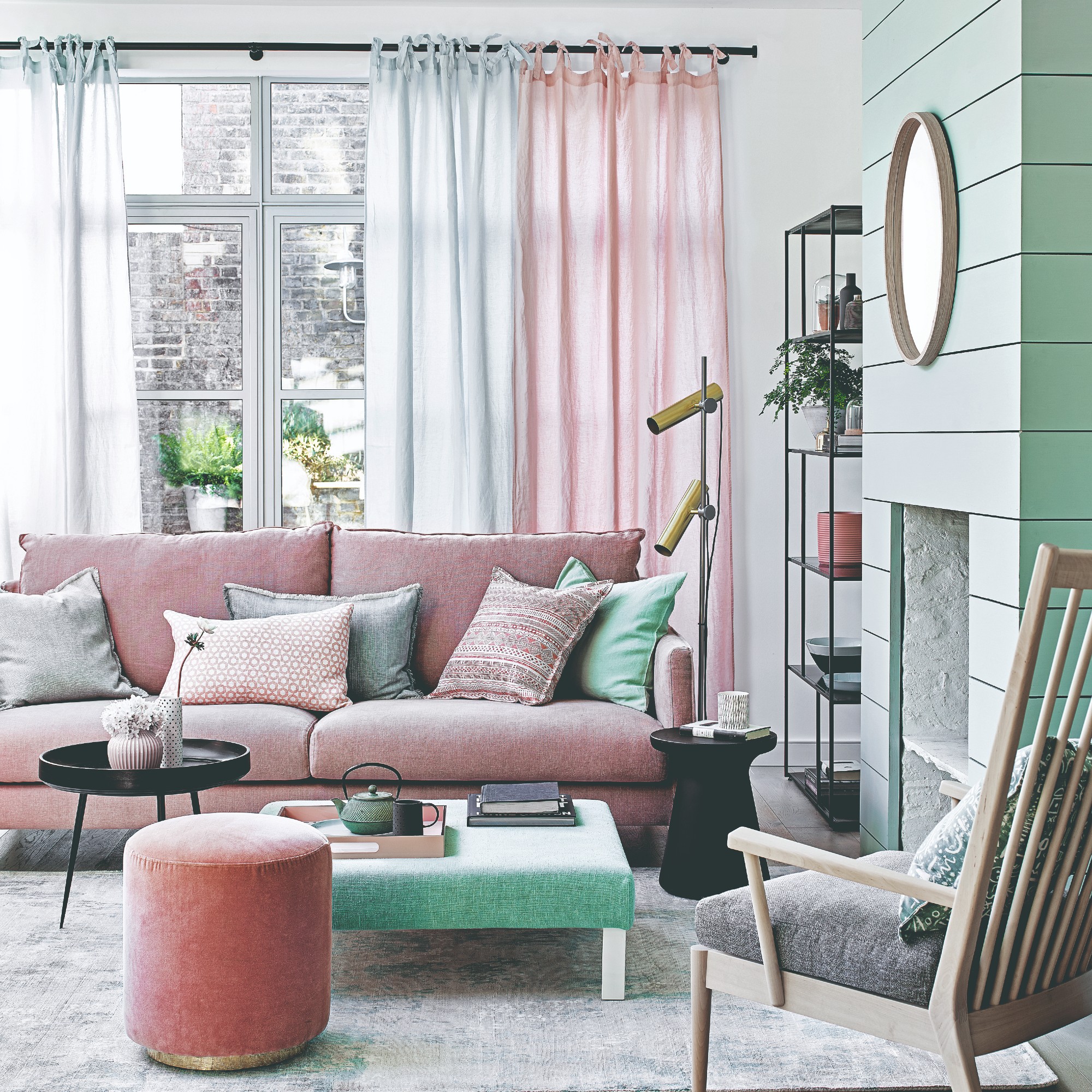
When choosing the best curtain colours for your living room, just remember the overarching colour rule of dark shades making things appear smaller and that light shades visually expand things.
‘When working with a slightly smaller space, I’ve found that colour choice can make all the difference in how open and inviting the room feels. If you’re worried about your space feeling cramped, I’d recommend steering clear of darker shades like deep blue or charcoal,' Anna at Furn explains.
'These heavy colours can overwhelm the room, making it feel smaller than it is. White is a fantastic colour for reflecting light and creating an airy atmosphere, but I know it might not be the best option for everyone -especially if you have pets or kids running around. If white seems too high-maintenance for you, consider opting for a soft neutral, such as a pale blue or dusty sage green. These light pastel shades can brighten your space while adding a touch of colour and personality to your room.'
Ana at Blinds Direct adds, ‘When it comes to curtains for small living rooms, the lighter the better. There is a diverse selection of light yet warm neutral colours including beige and taupe which will make a room feel larger and cosier.’
6. Choose your curtain patterns carefully
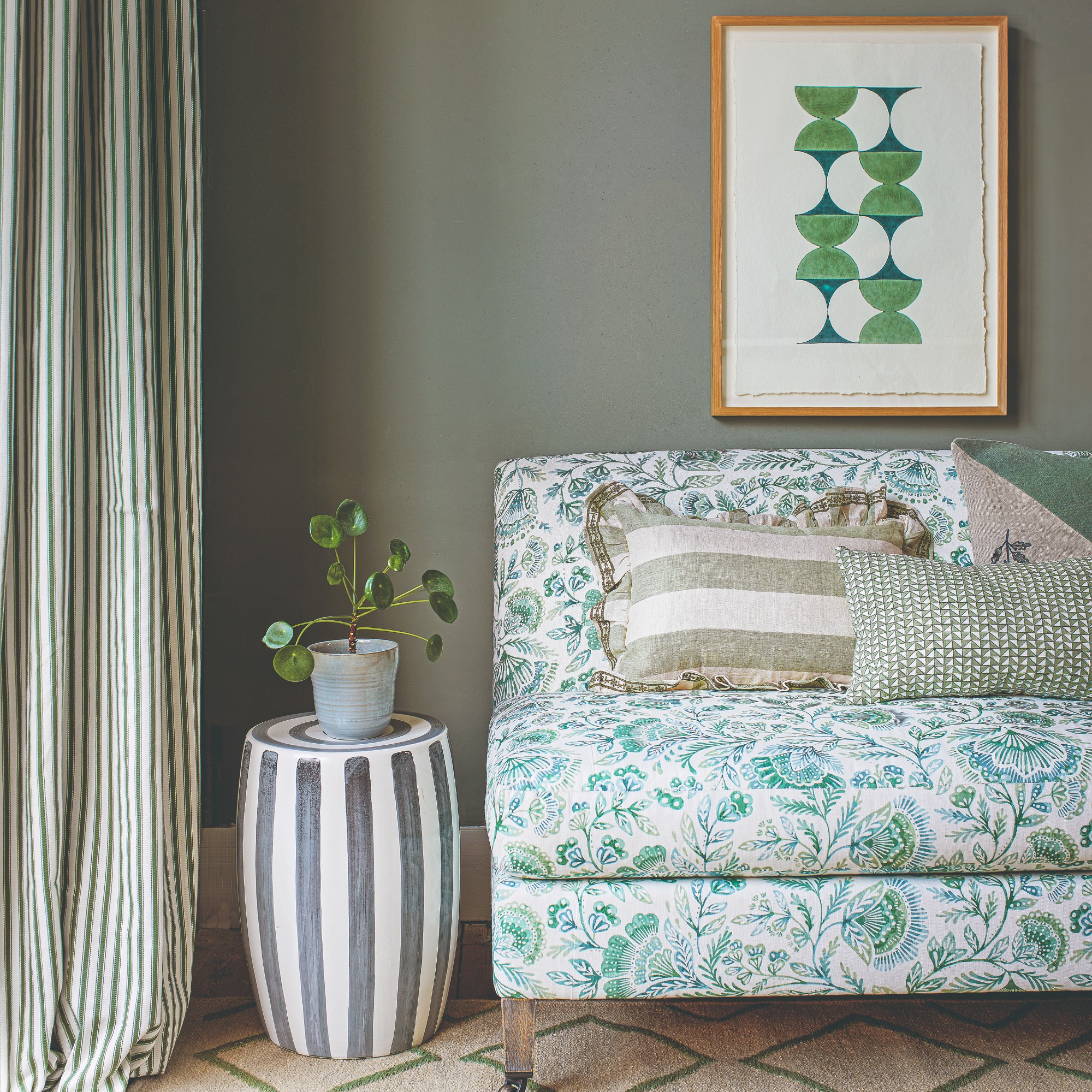
‘Don’t shy away from patterns in your decor! One common misconception about small spaces is that you can't incorporate patterns. You can – it’s just about finding the right pattern for your space and style,’ Rea at Furn says.
There is a handful of patterns that work particularly well in small living spaces but the best and most popular tend to be stripes.
‘Stripes are fantastic for small spaces because they create an illusion of length, helping your small living room feel more expansive. Plus, they’re everywhere in interiors right now, so you’ll be right on trend. Don't be discouraged from using patterns like florals and jungle prints if that's your style. To balance the busyness of these designs, keep the rest of your space clutter-free and opt for neutral accessories,’ Rea advises.
How to make a small living room look bigger with a sofa
7. Pick seating with legs
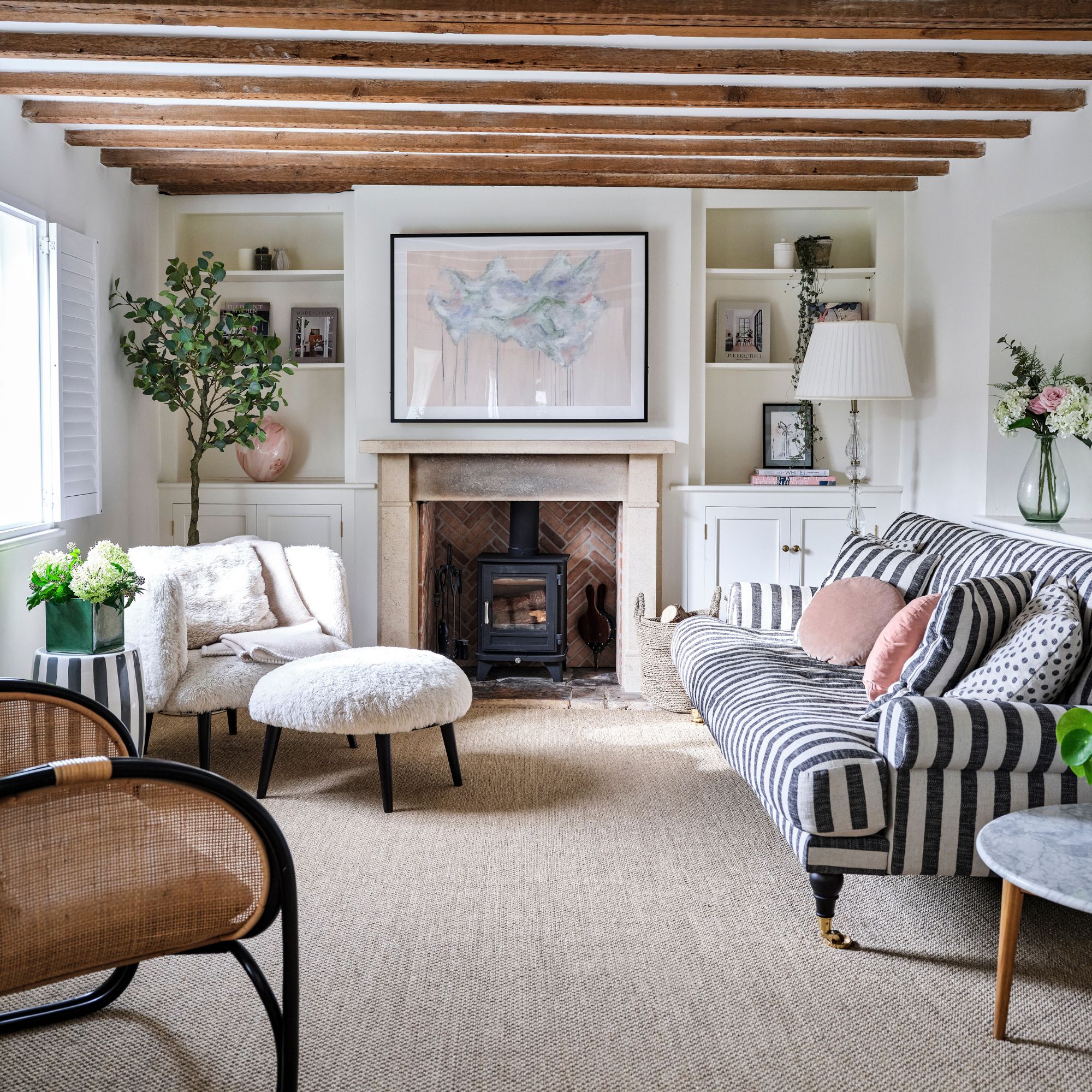
When it comes to the best seating ideas for a small living room, going for sofas and chairs with legs is ideal as the extra room underneath creates the illusion of a bigger space.
‘Sofas and chairs with exposed legs give a feeling of openness,' says Paige Holt, interior trend writer at ScS. 'Avoid bulky furniture that sits directly on the ground – floating designs are your friend.'
8. Go for neutral or pastel upholstery

Neutral tones have long been considered the masters of illusion. There’s a reason why so many sofa brands offer so many options in these colours. Neutral sofas allow you to bring an effortlessly stylish neutral living room to life, and there are more colour options in this category than you’d think.
‘Shades like beige, cream, light grey or even a 'new neutral' like sage offer a sense of openness by reflecting light, making the space appear airier, brighter and less cramped,’ says Francesa Hadland, interiors expert for Bridgman.
But if you want to inject a little bit more colour into your small living room with your sofa, pastel shades will do the trick, too. 'Opt for sofas in pastel colours as they reflect light well and make the space feel more open,' says Eric Bramlett, founder of Bramlett Partners. 'Light blue, for example, can give a room a coastal, breezy feel, while pale pink adds a touch of sophistication and warmth.’
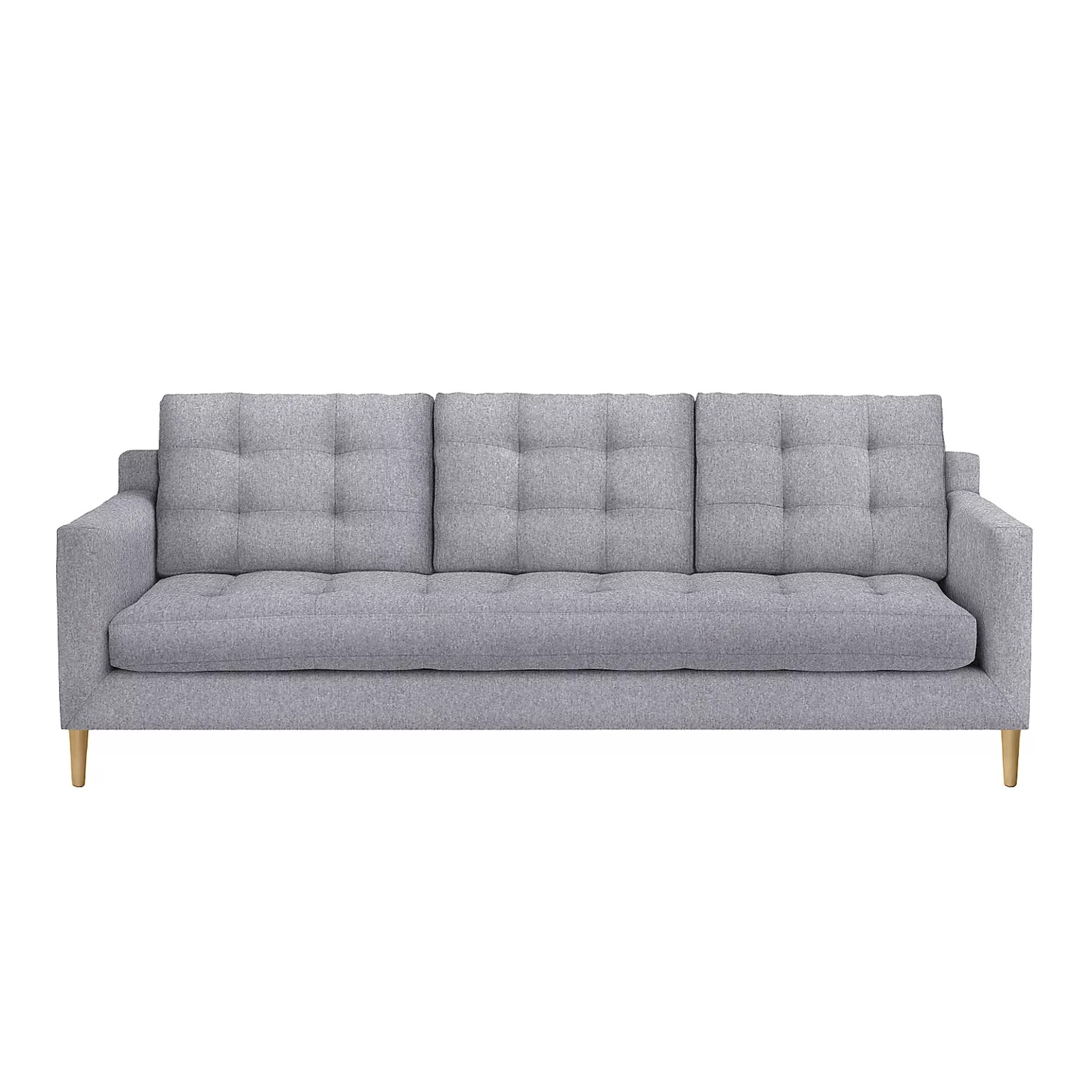
Taking the top spot in our best sofas buying guide, the Draper sofa is the perfect all-rounder. And it's slim profile and armrests, along with slim legs make it perfect for a small living space.
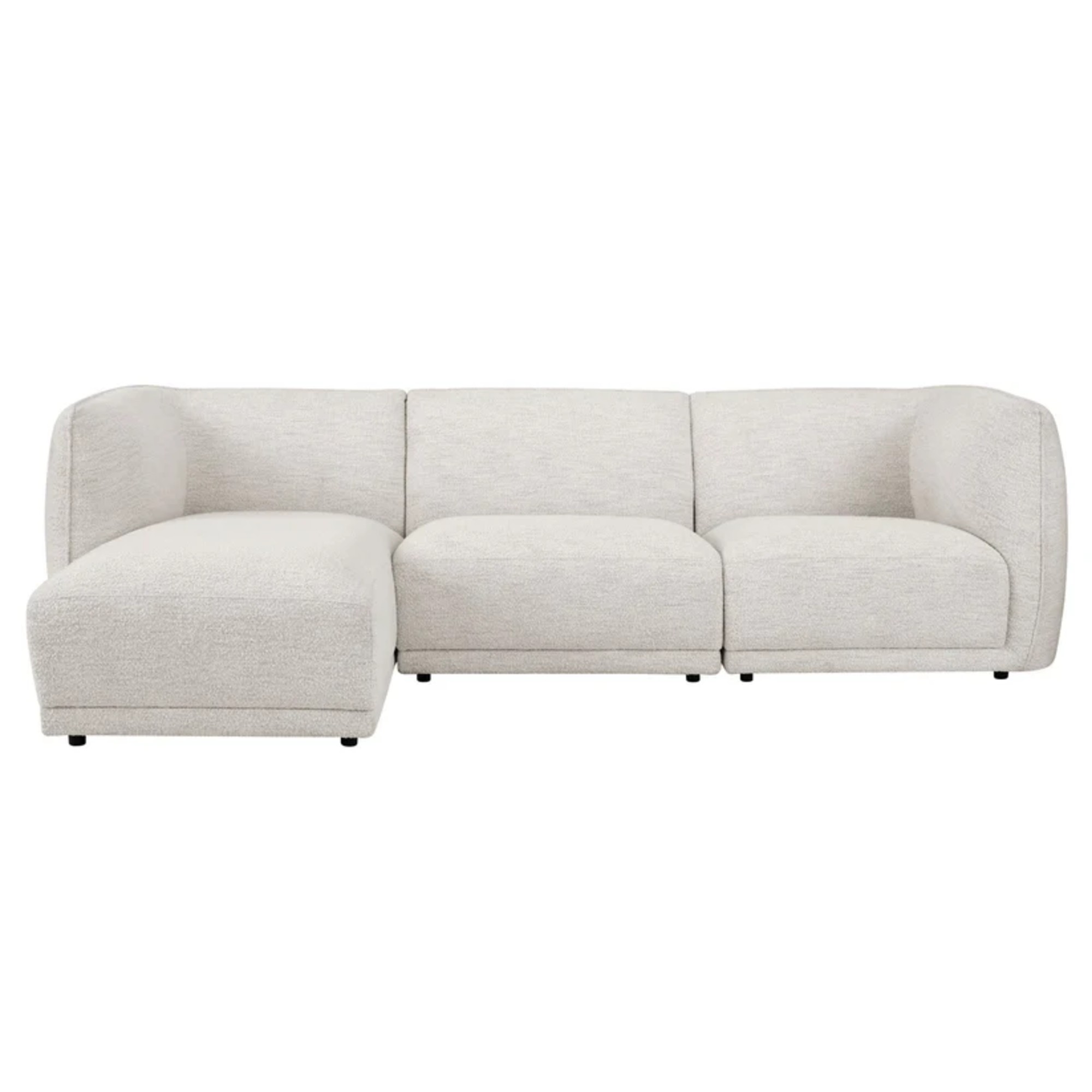
With their versatility and flexibility, modular sofas also make the ideal choice for a small living room - especially if you opt for a design in light upholstery like this ivory boucle.
How to make a small living room look bigger with mirrors
9. Go big with mirrors
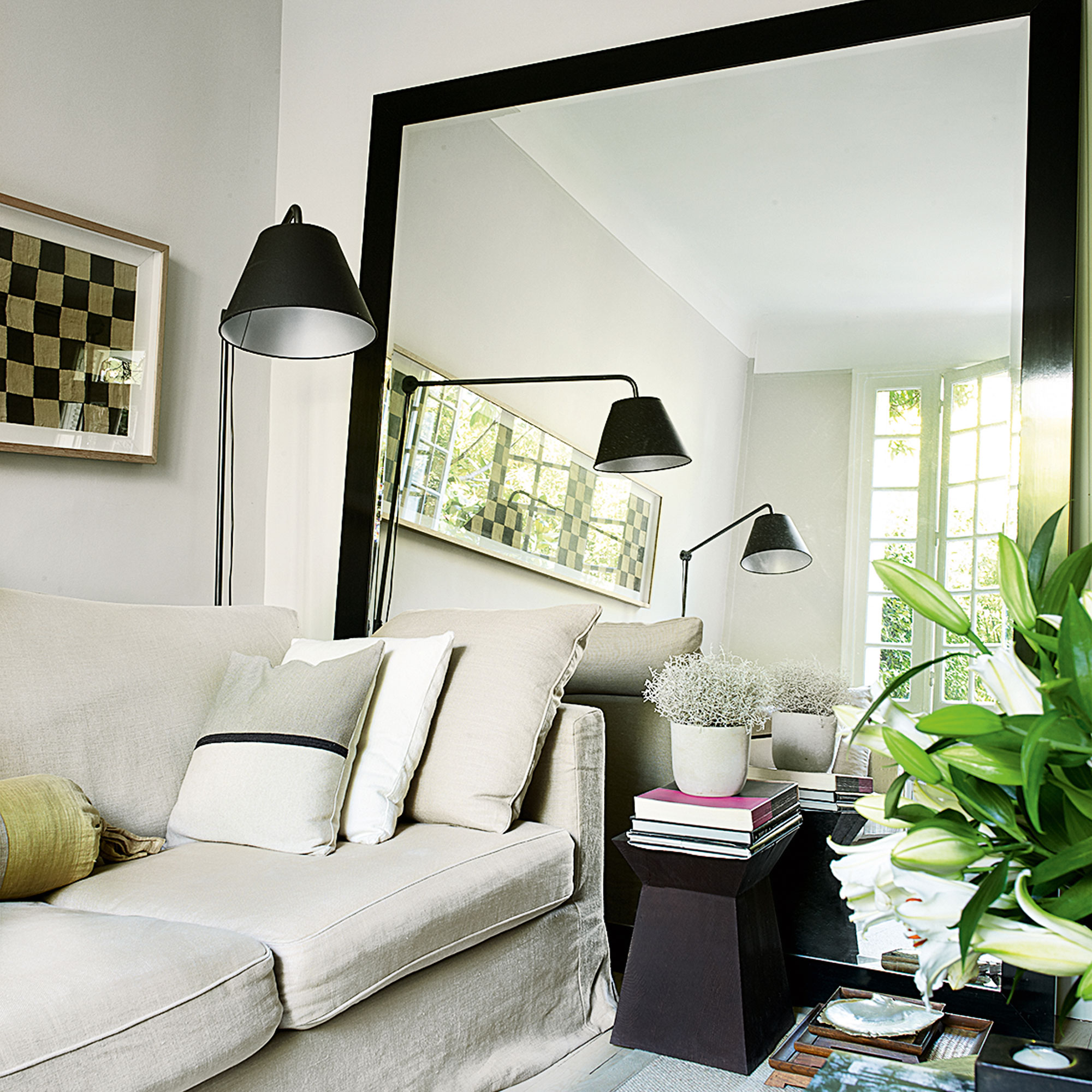
'Play with scale – a huge circular mirror on the wall or an ornately framed mirror leaning against a wall will transform a compact space,' says Danielle Le Vaillant, head of photography and film at Cox & Cox.
If you have the room for it, a large floor mirror propped on the floor will maximise light in the room because of its bigger reflective surface. It's important to make the mirror work with your space though – go for a style and design that goes seamlessly with the rest of your decor, rather than one that feels out of place.
10. Place a mirror opposite a window
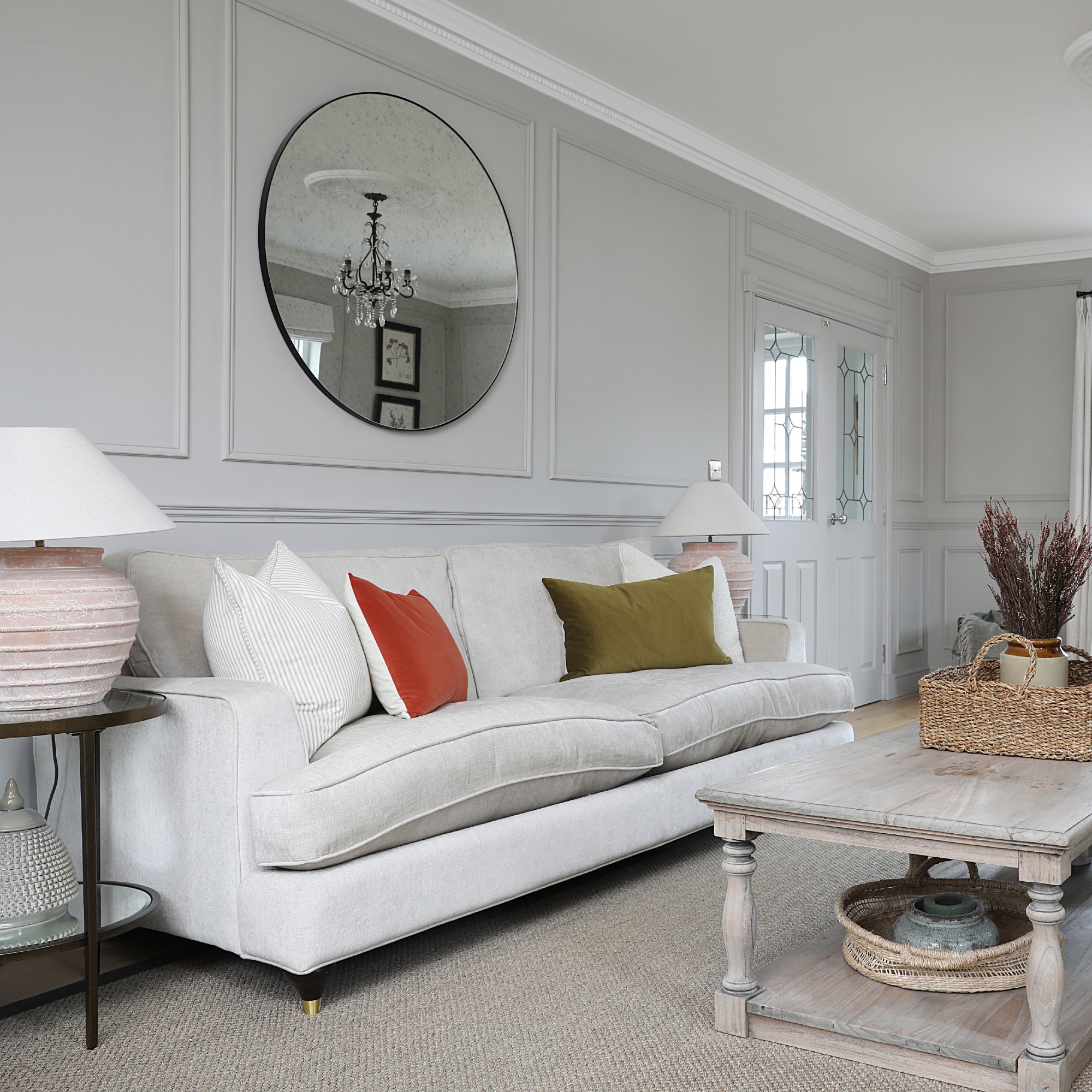
Where you place the mirror is key, as it needs to be in a position where it is going to maximise the light in the room. One of the best positions for a mirror in smaller living spaces is opposite a window, so that it reflects the natural light entering here.
'Try to ensure that it will catch and reflect as much natural light from any windows as possible. Reflected greenery, from either a garden or indoor plants will also deepen the field of vision and increase the sense of space,' Danielle at Cox & Cox says.
11. Hang a mirror above the sofa or a mantelpiece
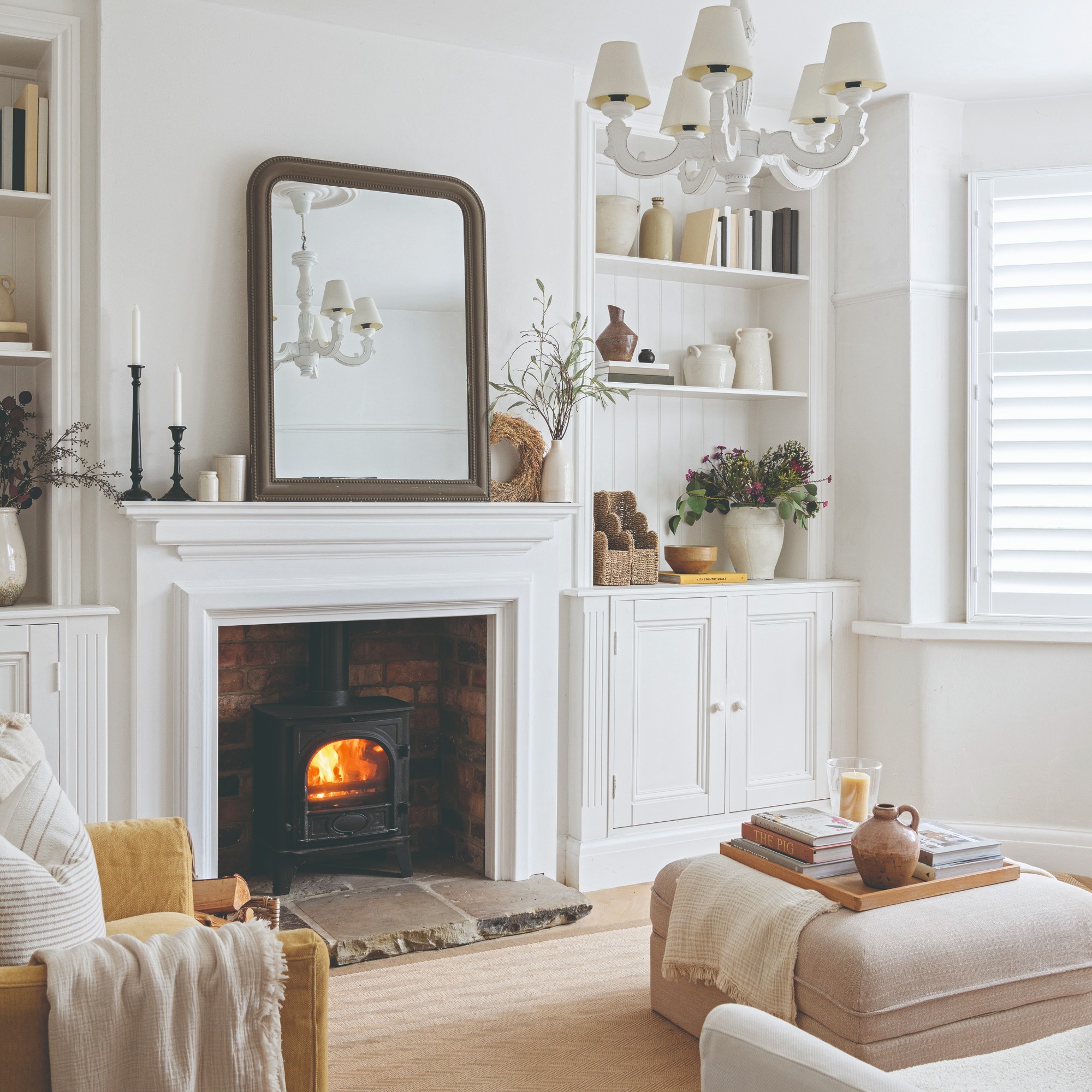
If you're lacking wall space opposite your living room window, there are other ways you can strategically place a mirror to make the space feel bigger. Try incorporating a mirror into living room fireplace ideas, which are already a natural focal point in the room.
'Positioning mirrors above a sofa or mantlepiece will draw the eye upwards, creating a sense of height,' explains Emma Deterding, founder and creative director of Kelling Designs. 'You can also try placing mirrors behind lamps on a console or side table to help further reflect the light from the lamp back into the space, making it feel bigger and brighter.'
12. Incorporate multiple mirrors
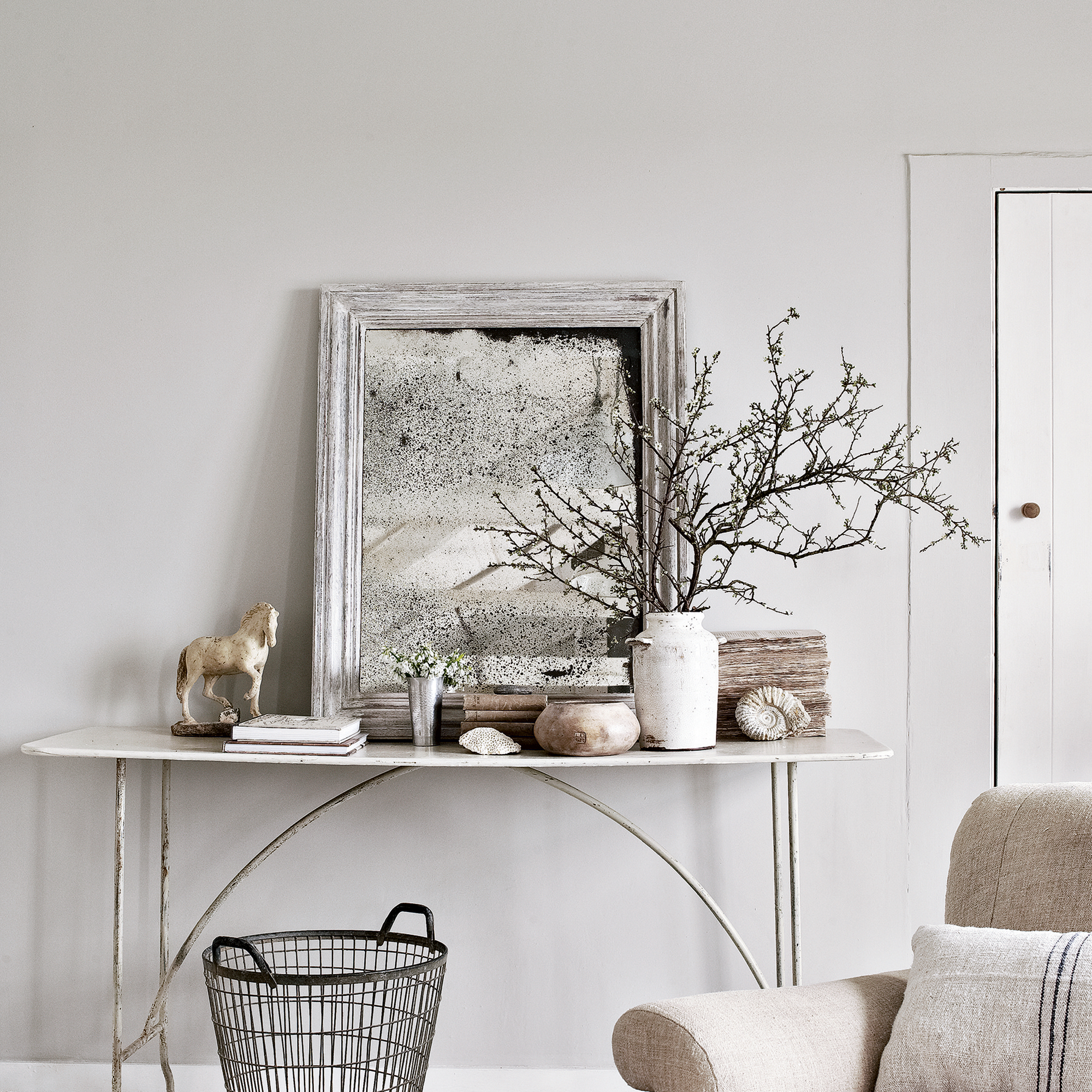
The idea of using mirrors to make a small living room look bigger is based around them being able to reflect and bounce light around the room. The lighter a space is, the bigger it feels.
Try incorporating multiple mirrors into the living room if you can. You could have a small mirror placed near a console or side table, then a bigger one on the wall opposite the window. They will both help to reflect light around the room, contributing to a more open, spacious feel.
13. Get a curved mirror
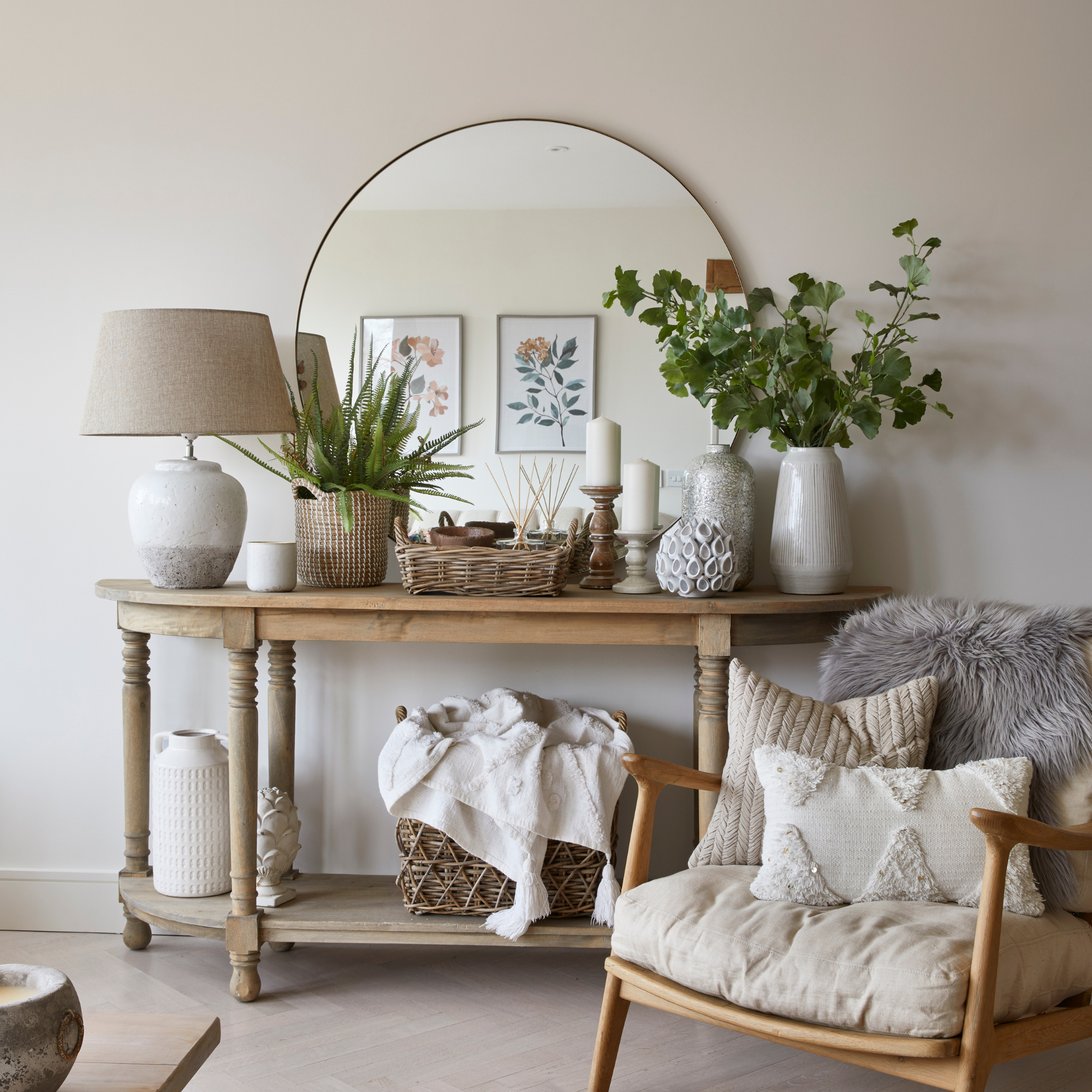
It's a good idea to also be strategic with the shape and style of the mirror you're using, if you want it to make a difference to how big your living room feels. Firstly, you'll want to pick a design that complements your existing living room decor – if it looks out of place, it will feel like it takes away from the space rather than adding to it.
'Circular mirrors can help to soften the lines in a room, creating a stylish focal point without overwhelming the space,' Emma at Kelling Designs says.
How to make a small living room look bigger with decorating
14. Add wall panelling
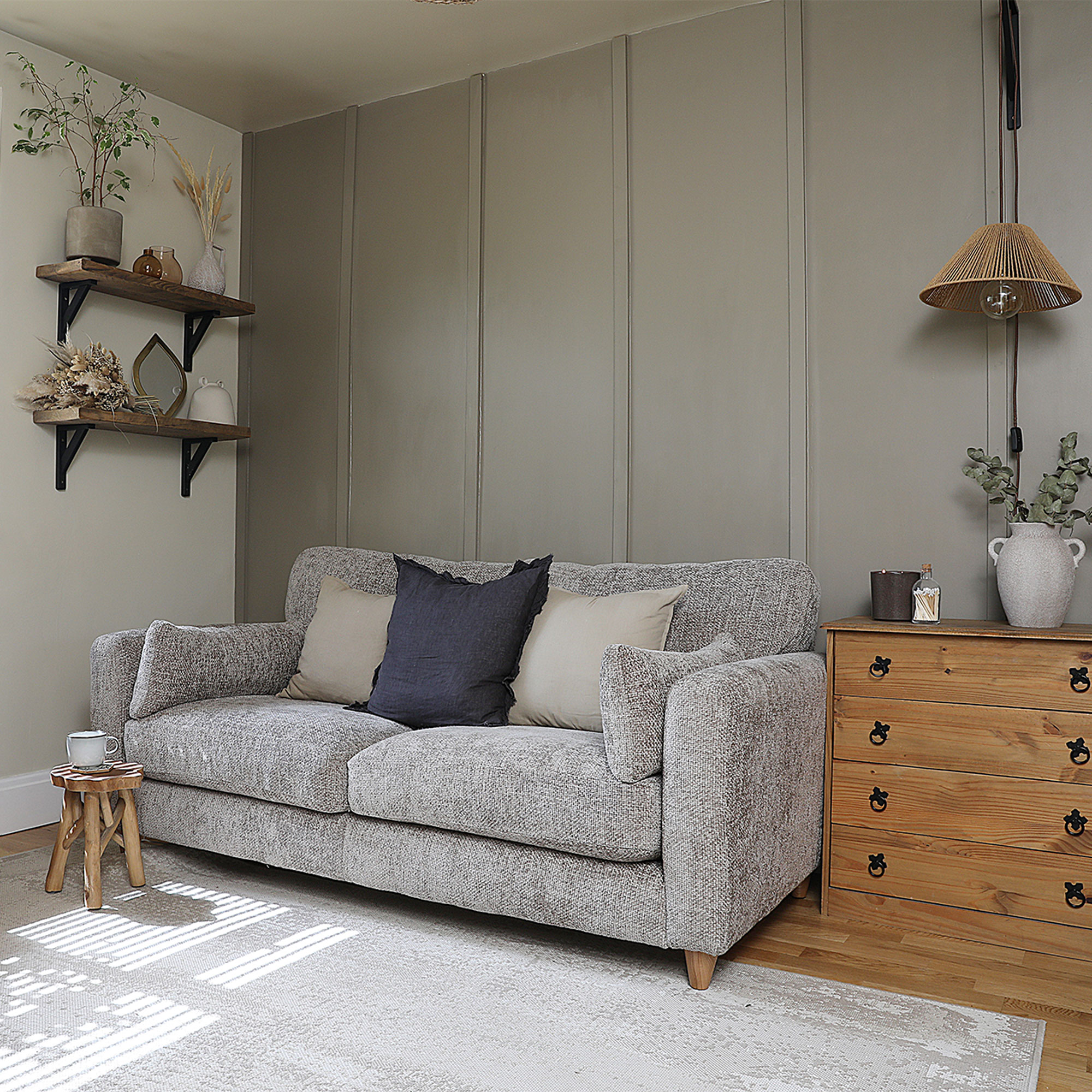
Just because there’s not a lot of space to work with that doesn’t mean you can’t add decorative features to your small lounge – just go for those that don’t take a lot of (or any) room. Living room wall panelling ideas are the perfect thing to go for.
‘Use wainscoting and trim for any small spaces,’ says Colleen Bennett, founder of CBB Design Firm. ‘Wainscoting and trim give a room height. When I'm designing a space, I want to make it look big and make it look luxurious. Wainscoting helps make the small space appear bigger.’
15. Layer your lighting
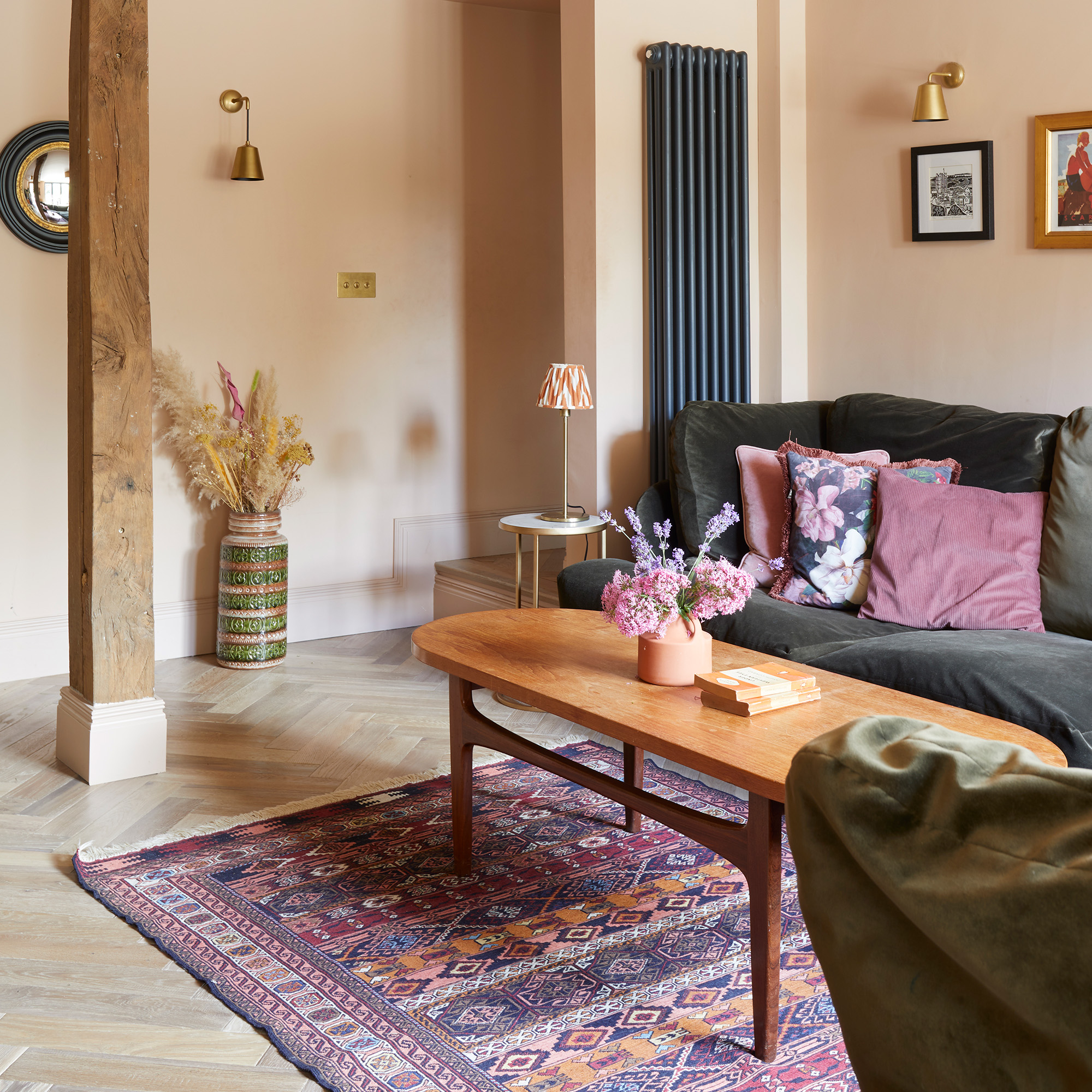
When it comes to small living room lighting ideas, not relying on just a single overhead light source is the number one tip from lighting experts. A single light is inadequate for any room, big or small, but in a living room, where a relaxed mood and cosy atmosphere is a must, a single overhead light will feel harsh and stark and not conducive to relaxation at all.
‘We would always suggest using multiple light sources in a living room,’ advises David Amos, founder of Amos Lighting . ‘If you have different light types around the room it can not only eliminate shadows but create an appealing layered lighting effect, making the room naturally feel bigger. For example, you can incorporate different temperatures that project a different coloured glow or level of brightness.’
‘We’d also suggest avoiding any bulky and large ceiling fixtures in a small living room. Whilst they can be an eye-catching addition to the room they can make the room look smaller and cause it to feel top-heavy.’
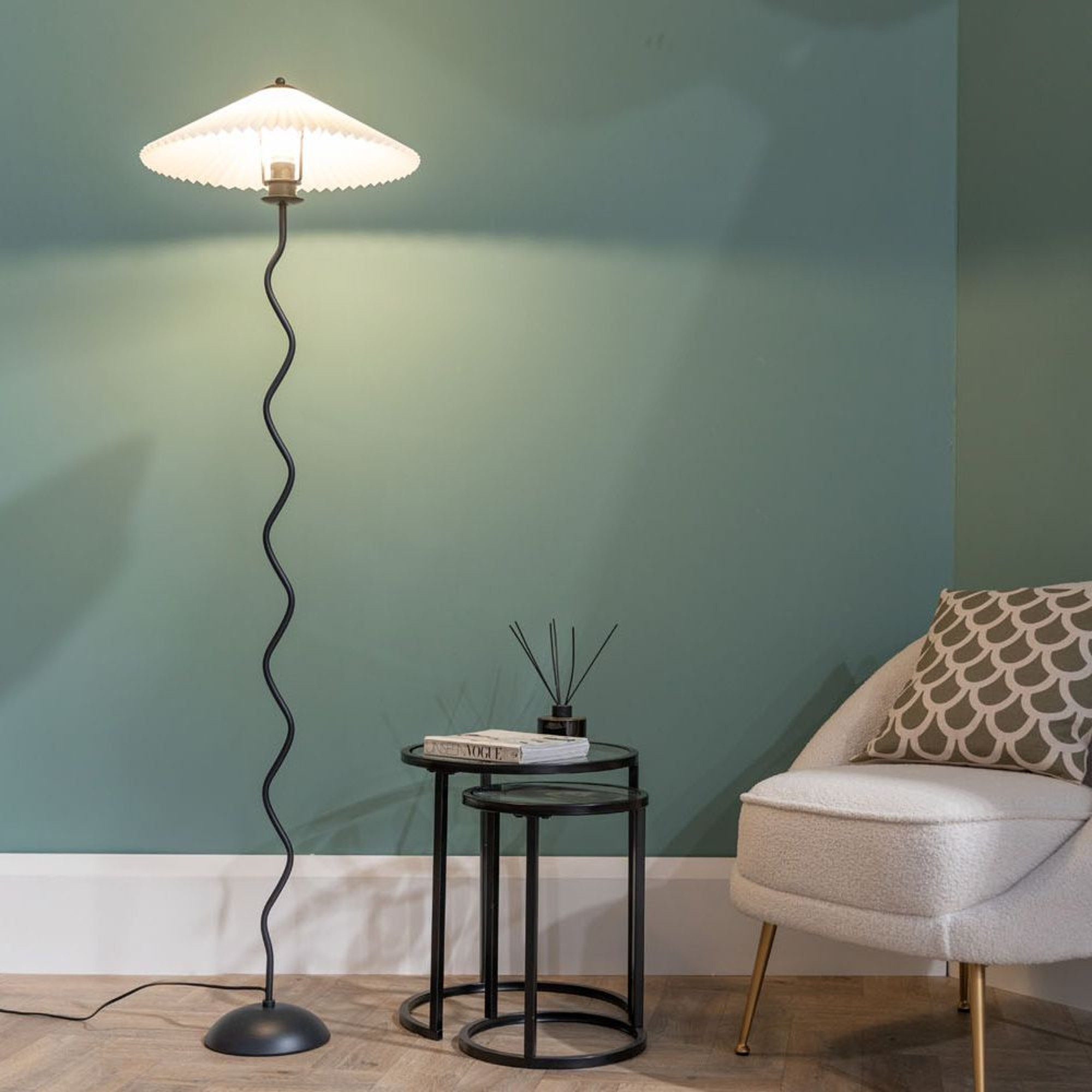
Incorporating a wiggly floor lamp like this one into your small lounge will add a sense of movement.
16. Invest in a large rug
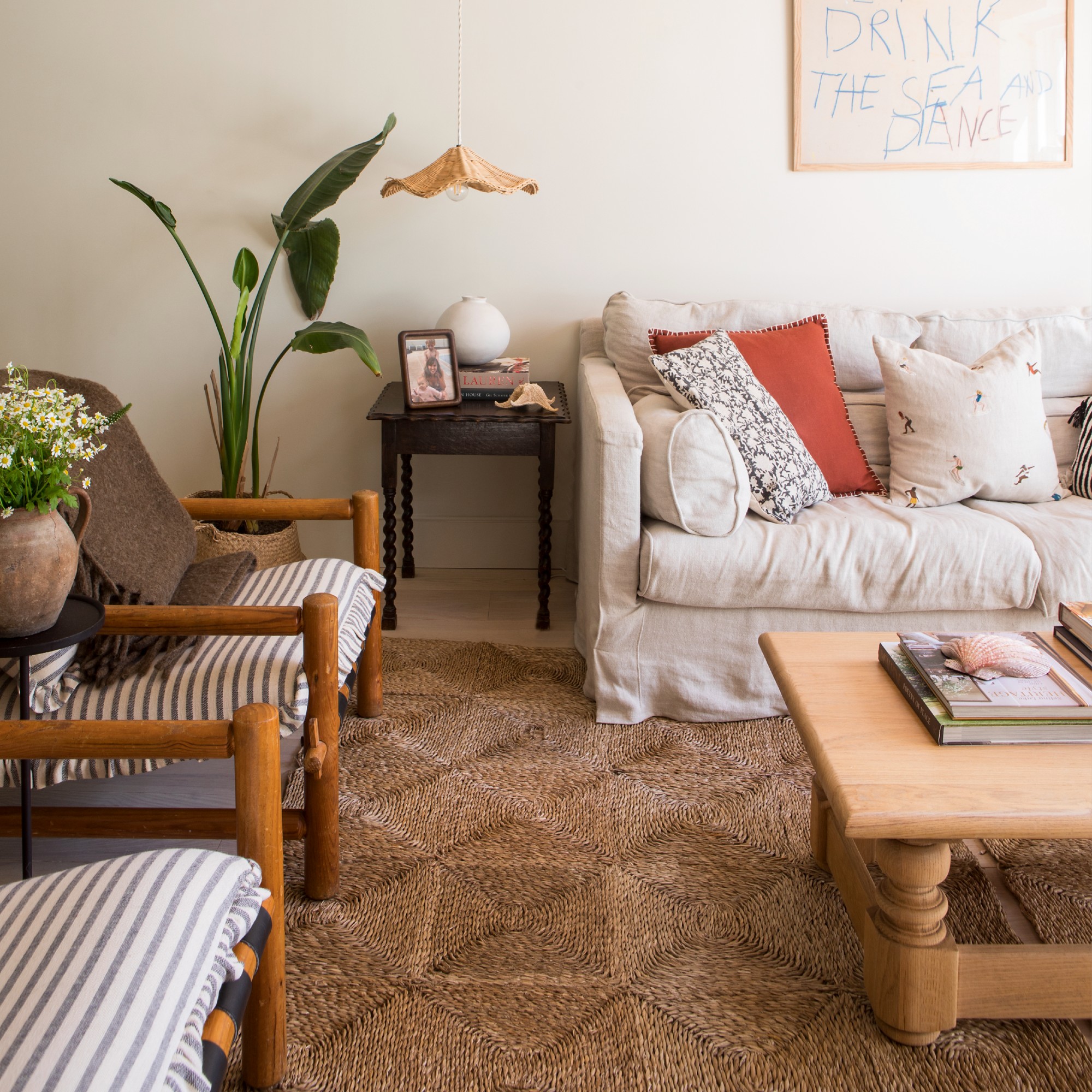
When it comes to living room rugs, big is better, especially in small living rooms. It might seem counterintuitive, but a large rug can help to stretch the space, drawing the eye and making the floor area feel bigger.
'A rug grounds the space and sets the tone for the rest of the room,' says Lena Gierasinska, head of product and displays at Barker and Stonehouse. 'Choose a rug that’s large enough to sit under the front legs of your furniture – this helps zone the space and makes it feel more expansive.'
Go for a rug that is as large as (or even wider) than your sofa if you can. Run it under the legs of your sofa as well as the coffee table if possible and try to leave around 25-30cm around the edge of the room so you can still see the floor beneath.
How to make a small living room look bigger with furniture placement
17. Leave some breathing space
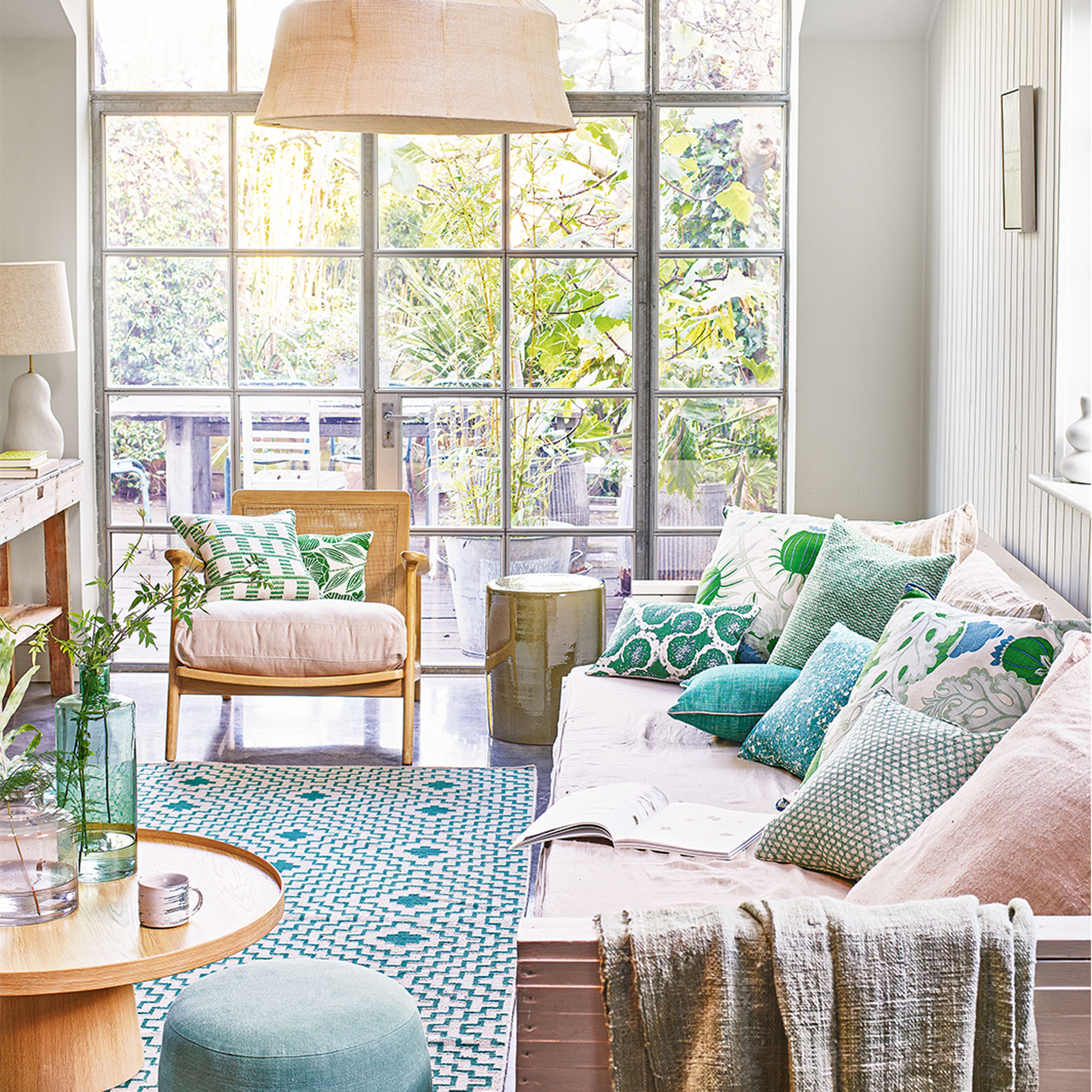
When living room space is tight, avoid over-filling the room with too many large bulky pieces of furniture that can block the light and make the room feel crowded and hemmed in. Knowing how to arrange furniture in a small living room can make a big difference.
'In a small living room, it is especially important to avoid clutter as that will make the space look too busy. Avoid overcrowding the room with too much furniture and leave space between each piece so that the eye can easily flow around the room. The most important thing is to make sure you have plenty of storage so that the space remains clean, clutter-free and inviting,' Shelley at Furniture Village says.
18. Pull furniture away from walls
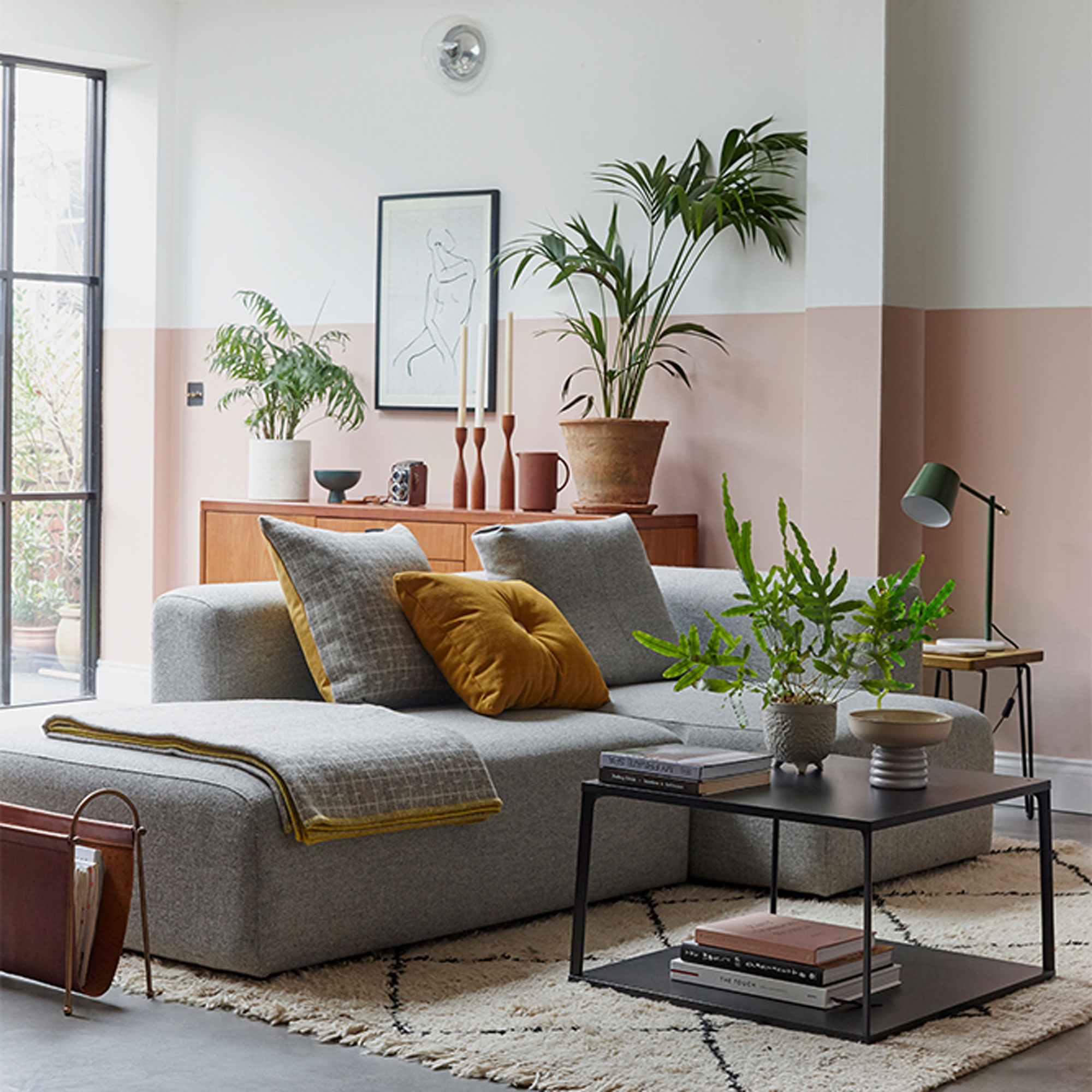
While it’s tempting to push all the furniture against the walls in a small living room to put more floor space on show and make the room feel bigger, it can actually have the reverse effect. Having everything pushed up against walls can limit the sense of space and horizon, making a living room appear much smaller.
Try pulling sofas and armchairs away from walls to give them more breathing space. An easy solution for how to make a small living room look bigger, it will also make the room feel more inviting. No more dead space in the middle of the room. Group seating together to create a more relaxed, sociable feel.
19. Open up the view

In a through-lounge or open-plan living room ideas avoid positioning furniture where it might block the view into the next area or across the space. Positioning larger items and bulkier pieces of furniture away from walkways will help to open up the space more and make it feel bigger.
Use round coffee tables and occasional seating between chairs and sofas. Curves are much easier to navigate around in tight spaces, with no sharp corners to bash into.
FAQs
What colours make a small living room look bigger?
Colour is a game changer when it comes to small living rooms. Using muted colours and soothing shades throughout can help to calm a busy space, help with how to make a small living room look bigger and create a cohesive look that in turn feels more spacious and easier on the eye.
‘When selecting colours for your living space, think about how you would like the space to feel,' says Ruth Mottershead, creative director at Little Greene. 'Perhaps consider soothing, tranquil green tones or more natural neutrals to bring warmth and harmony to the room.'
‘Neutral paint colours set the scene for harmony and tranquillity, while muted tones reflect nature at its purest and these gentle tones can warm cooler spaces and breathe light into darker rooms.’
What pattern makes a small room look bigger?
Stripes are a failsafe choice that can instantly help with how to make a small living room look bigger. Wide bands of colour or horizontal stripes on wallpaper or wall panelling (laid width-wise) can all help to make a room feel wider.
Similarly, narrow vertical stripes and linear timber panelling will create the illusion of height and make a low-ceilinged room feel loftier.
So if you have a small living room, don’t fret – there are clearly ways and methods you can use to rectify that.

Sara Hesikova has been a Content Editor at Ideal Home since June 2024, starting at the title as a News Writer in July 2023. She is now also the Ideal Home Certified Expert in Training on Furniture, and so far has tested over 150 different sofas.
Graduating from London College of Fashion with a bachelor’s degree in fashion journalism in 2016, she got her start in niche fashion and lifestyle magazines like Glass and Alvar as a writer and editor before making the leap into interiors, working with the likes of 91 Magazine and copywriting for luxury bed linen brand Yves Delorme among others.
- Lisa FazzaniFreelance content editor
